




City of Davis and Yolo County bring back ‘Campamento Alegre’ for children at Davis Migrant Center
BY ALMA CULVERWELL city@theaggie.org
Tis year marked the return of the “Inclusive Parks, Inclusive Hearts: United Communities Trough Recreation!” series from the Davis Parks and Community Services (PCS) Department and Yolo County Housing. Both of these organizations brought recreational summer programming and fve days of educational and fun activities to the children at the Davis Migrant Center with “Campamento Alegre,” which translates to “Happy Camp.”
The Davis Migrant Center, operated by Yolo County Housing, is home to approximately 55 children for seven months out of the year. Many children have grown up at the center, rarely participating in the city’s recreational programming.
In August, PCS staff provided activities such as soccer, line dancing, art, painting, origami, s’mores making, a charcuterie class and more. By hosting the activities on-site and ofering programming in Spanish, the event eliminated costs and logistical challenges related to transportation and
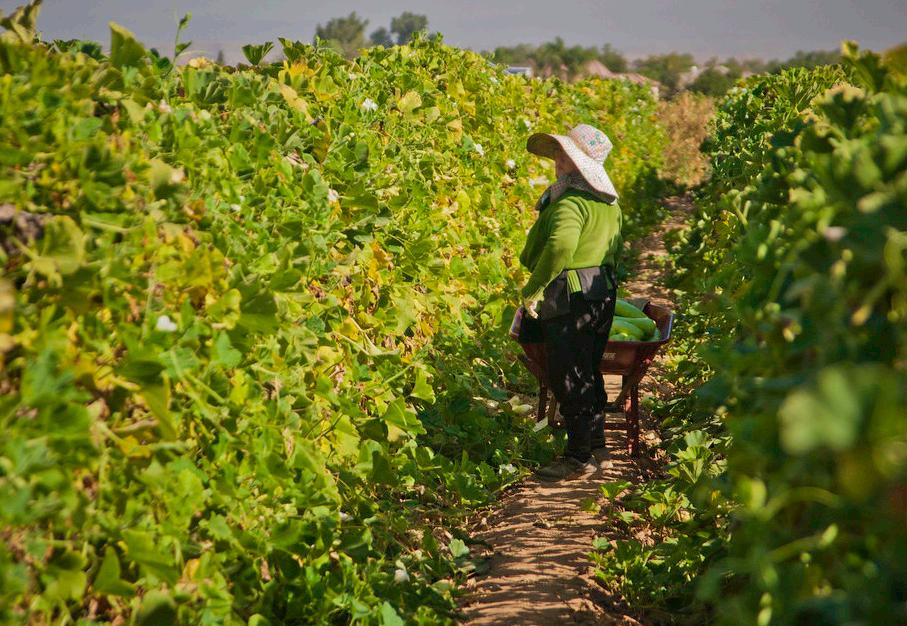
enrollment.
Funding for the program came from the city’s American Rescue Plan funds, allocated by the city council, alongside donations from a local faith-based community.
Last year, the city partnered with
Yolo County Housing to provide a three-day soccer program that hosted 25 children as participants. Te program also involved a special snow cone food truck visit and a pizza party.
“We have so many wonderful partners that support our families at
What factors are considered in the WSJ ranking and what do students at Davis think?
BY ZOEY MORTAZAVI features@theaggie.org
On Sept. 5, Te Wall Street Journal (WSJ) released its updated ranking for the top universities in the country. Both in the public school category and overall, UC Davis has seen a signifcant rise in its national rank over the last few years — but this year’s ranking has placed our campus at a record high.
Davis was ranked by the WSJ as No. 3 among public schools in the United States. Te WSJ methodology weighs fnancial factors such as the salaries of college graduates more heavily than other factors in its ranking, which has caused some skew in terms of its usual top contenders.
To that end, the WSJ overall ranking was met with some controversy this year, and many people questioned their ranking process. Many college publications, including Te Chronicle based out of Duke University, referred to the WSJ rankings as “a joke,” saying that they’re taking the wrong factors into account when establishing the national rankings.
Sophia Caster, a second-year international relations major, shared her thoughts on UC Davis’ rise in academic recognition.
“My experience at Davis has been amazing,” Caster said. “Davis’ rank moving up to the No. 3 public university is so exciting, and [it] makes me proud to go to a school that is getting recognized for its academics. I’ve never paid too much attention to school rankings, but I feel that school rankings can be important when choosing the school that’s right for you.”
Davis now ranks No. 33, tied with Georgia Tech, UC Irvine and the University of Illinois, in the list of overall best universities, according to the U.S. News & World Report’s 2025 ranking released on Sept. 24. Davis is also ranked at No. 198 in their list of best value schools nationwide. For public universities, U.S. News placed Davis at No. 9.
Popular rankings such as the U.S. News or the Forbes ranking, which placed UC Davis as the No. 43 best

university, take many factors into account, including but not limited to graduation rates, frst-year retention rates, borrower debt and the studentto-faculty ratio.
As these vastly diferent numbers show, none of the most prestigious college rankings consider the same characteristics or place universities at the same level. Phoebe Anzalone, a second-year American studies major, said that students should not base where they attend college on rankings alone and should consider other factors.
“I’ve never really believed that college rankings should be the sole deciding factor for students about where to go to college,” Anzalone said. “I don’t think any list of the best colleges should be what convinces you to go there. Te actual school experience, location, organizations and so many other things should help you make that choice — not just how ‘good’ the rest of the country considers the college you go to.”
Te Wall Street Journal has established that it weighs its rankings a little bit diferently than others. Teir formula refects how schools improve their students’ chances of graduating on time, along with how much they boost student salaries following their graduation. Te rankings are based on weighted factors that include
student outcomes (70%), learning environments (20%) and diversity (10%).
“We look at how much a school improves students’ chances of graduating and their future earnings, balancing these outcomes with feedback from students on college life,” Wall Street Journal editors said in an article published by UC Newsroom. “Public schools are prominent among those that climbed the ranking this year.”
Ekaterina Popescu, a second-year neurobiology, physiology and behavior major, shared her thoughts on Davis’ rising recognition for its academics on rankings across the board.
“Being a student at UC Davis has broadened my horizons in so many ways,” Popescu said. “As I am hoping to become a physician’s assistant in the future, being a student here has truly been a wonderful experience so far. From the several extracurricular opportunities and many internships and clinics available to join, Davis’ STEM and pre-med tracks are toptier. Especially as only a second year, I feel that by the time I leave, this university will defnitely have set me up for success.”
the center,” Yolo County Housing Executive Director Ian Evans said in a press release. “I’m thankful to my staf who care deeply about our residents, and we’re incredibly grateful to the city of Davis team for being creative and expanding the activities this year.”
Deanne Machado, the director of parks and community services for the city of Davis, explained how the programming has evolved and improved over time.
“Recreation is relational,” Machado said. “What that means is that all of the programs get better over time, especially with repeated exposure to the same sets of familiar faces
[...] Te camp ran a bit more smoothly because the returning children remembered us, trusted us and knew what to expect.
When asked what segment or class the kids liked best, many of them said ‘all of it.’”
Yolo County Housing Specialist Maria Pena said location, commute and parents’ work can pose difculties for children to engage in activities outside of what is offered by the childcare program.
“Campamento Alegre” aims to address this issue by bringing recreational and educational activities directly to the children at the center, ensuring they have access to enriching experiences without needing to leave the facility.
Read
Three years in the making, the new memorial includes doorways, mosaic and a mural to honor those affected by COVID-19
BY RORY CONLON city@theaggie.org
The Davis Cemetery District opened a new memorial dedicated to victims of the COVID-19 pandemic on Sept. 22. Located near the back of the cemetery, the memorial includes four doorways decorated to match diferent themes, a “refecting wall” with mirrors and mosaic and a mural painted by community members. Davis Cemetery Trustee Vice Chair Stephen Souza spearheaded construction of the project. Tree years ago, [Davis Cemetery Trustee] Heidy Kellison came to the board with the idea of building a COVID-19 memorial, and the board said, ‘We think we can do it,’” Souza said. “We proceeded to plan, and two years in, we issued a call to artists. Tat’s when I really started to feel as though we could make this happen.”
The four doorways, made of concrete and overlaid with colorful ceramic tiles, represent diferent themes selected by members of the Davis community: home, community, loss and hope. Wesley Horn, the lead artist on the memorial, recognized local Davis artists and community members that
contributed to the fnal product.
“Jennifer Nachmanof and Donna Lemongello, two fxtures and heavy weights in the Davis arts scene, spent countless hours in the studio making a lot of these tiles and hosting community build workshops,” Horn said. “300 plus community members are represented physically in the tiles and handmade ceramics on these portals. We had a number of open, free community build sessions in places like the Davis Craft and Vintage Fair, the International House and the Davis School of Independent Study.”
Once visitors of the memorial pass through the four doorways, they encounter a “refecting wall” complete with mirrors and colorful glass mosaic. Sheila Allen, the supervisor elect for District 4, said her refection in the glass emphasized how she, as well as everyone at the memorial, was impacted by the COVID-19 pandemic.
“Every person here, every person who’s not here and some of the people whose bodies now lie in this cemetery, were all afected by the pandemic,” Allen said. “Whereas it might feel better to say, ‘Yeah, let’s move on,’ I think taking a moment to remember is an important thing to do.”
COVIDMEMORIAL on 10
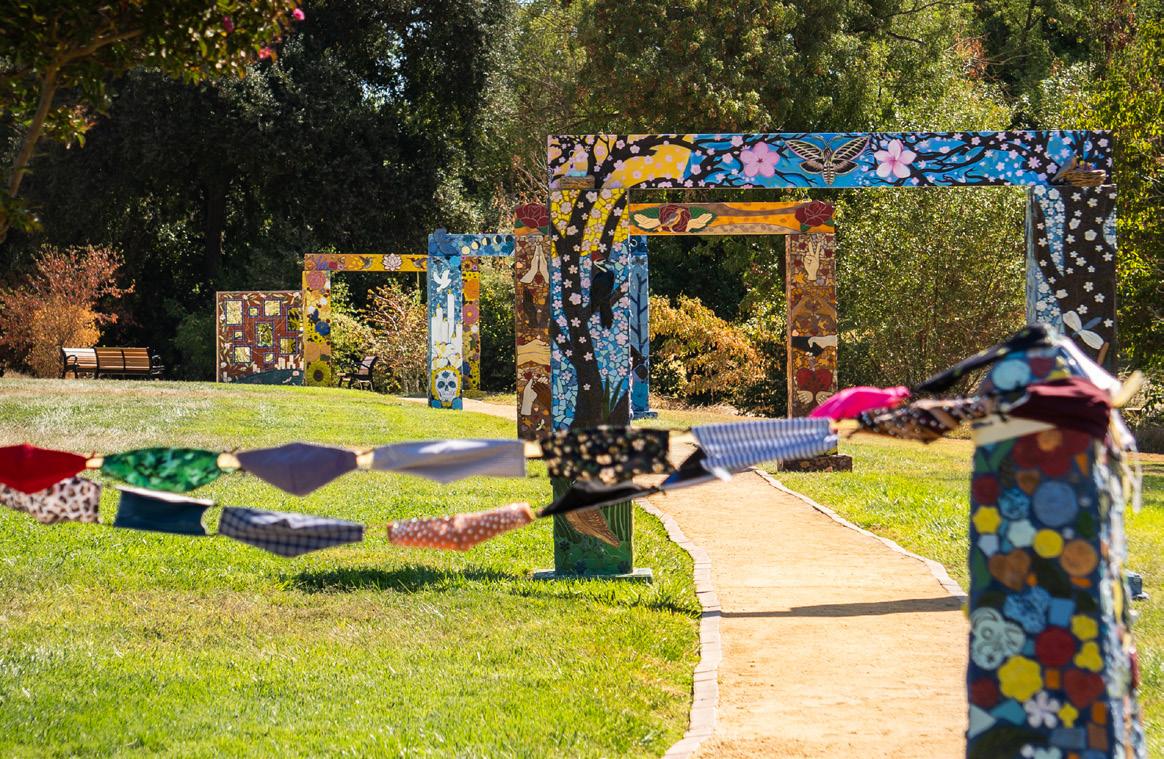
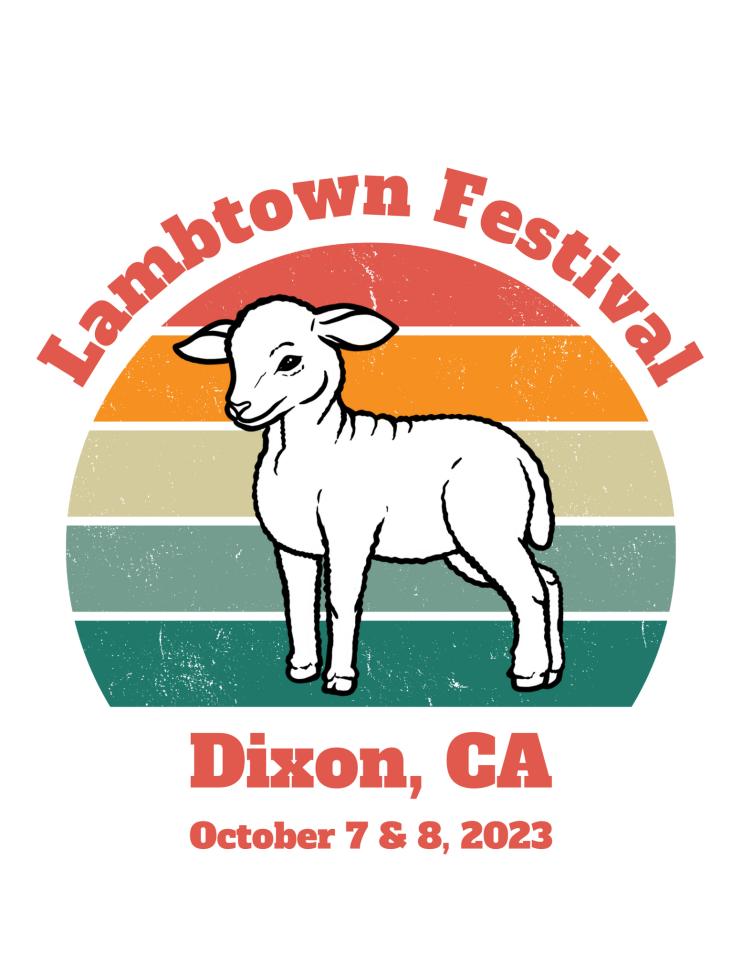
Davis y el condado de Yolo reviven “Campamento Alegre” para los jóvenes en el centro de migrantes en Davis
BY ALMA CULVERWELL city@theaggie.org
Traducido por ILEANA MERAZ Y SAMUEL RUIZ
Este año marcó el regreso de la serie de eventos, “Inclusive Parks, Inclusive Hearts :United Communities Trough Recreation!” organizada por el departamento de Parques y Comunidad y el departamento de vivienda del condado de Yolo California. Estos dos directivos revivieron lo que fueron cinco días de actividades que se enfocaron en traer una experiencia educativa y divertida para los niños y jóvenes de la área de Davis.
El centro de migrantes, que está en dirección del departamento de vivienda del condado de Yolo, se ha convertido en el hogar de aproximadamente 55 niños a lo largo de siete meses del año. Desde el tiempo de su apertura ha habido una gran cantidad de jóvenes que han crecido en el entorno del centro, no obstante, la mayoría de estos jóvenes rara vez han participado en actividades y otros directivos de la ciudad.
En Agosto los empleados del departamento de Parques y Comunidad organizaron una variedad de actividades que incluyeron, fútbol, arte, pintura, origami, cocina y mucho más.
Al alojar el programa en el centro de migrantes y al ofrecer todos los cursos en español, el programa eliminó el costo y retos logísticos relacionados con el transporte e inscripción de los jóvenes al programa.
Los costos para iniciar un programa de esta magnitud fueron cubiertos en parte por el apoyo de los esfuerzos de la ciudad de Davis adquiriendo los fondos del American Rescue Plan y la participación fnanciera de un grupo religioso local.
El año pasado la ciudad colaboró con el departamento de vivienda del condado para ofrecer un taller de tres días enfocado en técnicas de fútbol el cual inspiró a 25 jóvenes que se inscribieron a asistir. Además de las técnicas y entrenamiento los jóvenes gozaron de la visita de un camión que les ofreció raspados y una celebración con pizza.
“Tenemos una gran cantidad
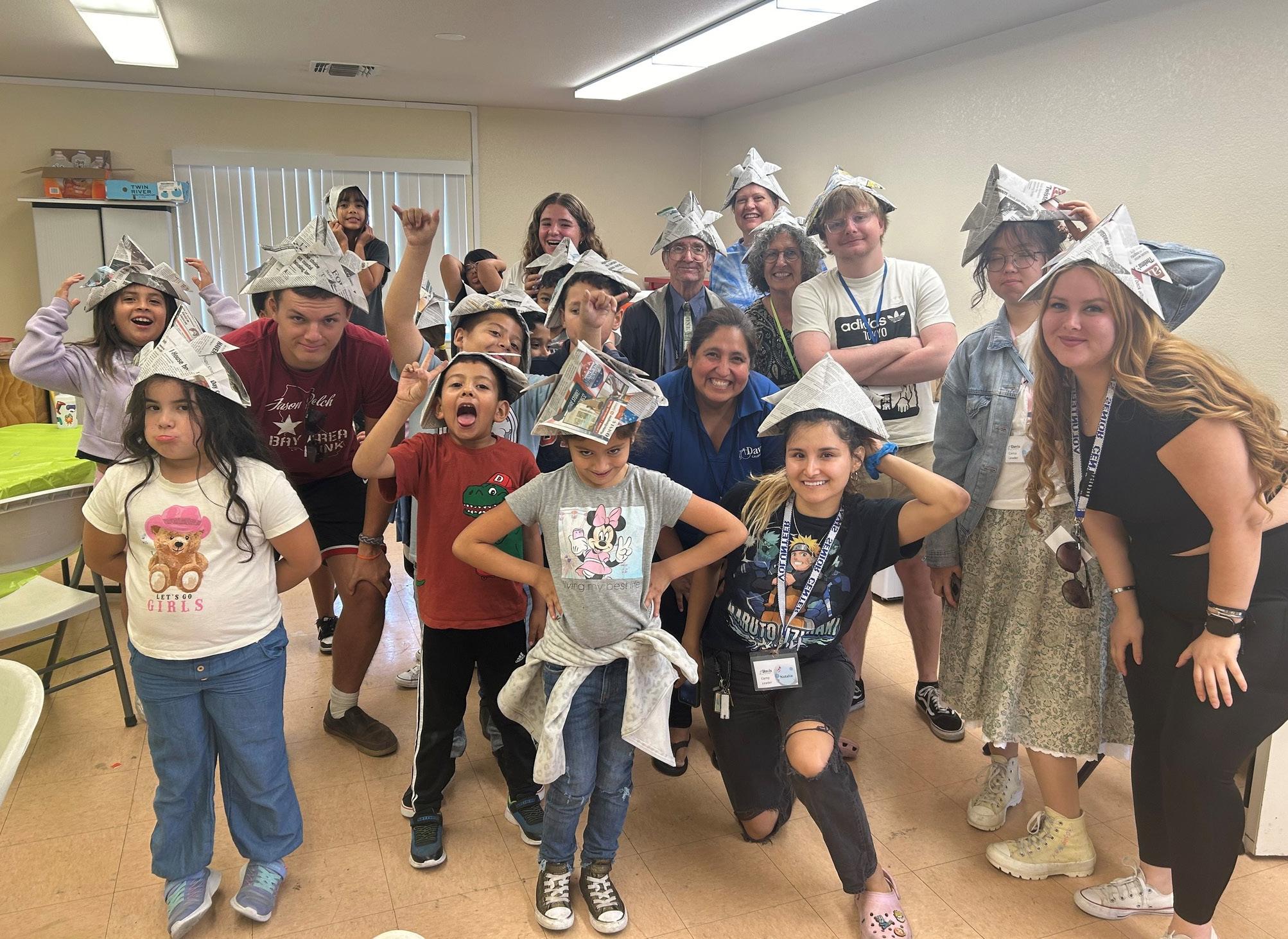
de socios que han apoyado a las familias,” nos explicó Ian Evans el director ejecutivo del departamento de vivienda en una entrevista de la prensa. “Estoy muy agradecido por mis empleados y equipo que han enseñado mucho cariño a nuestros residentes y como grupo en este esfuerzo estamos increíblemente agradecidos a la ciudad de Davis y su equipo en sus esfuerzos y su creatividad en expandir las actividades de este año.”
Deanne Machado, la directora del departamento de parques y servicios comunitarios de la ciudad nos explico como se a evolucionado el programa a lo largo del tiempo explicandonos, “La Recreación es relational,” Machado dijo. “A lo que me refero es que todos los programas se han mejorado al curso del tiempo
especialmente con el regreso repetido de los jóvenes que llegan al programa. Este año el programa puede ejecutarse con mejor fuidez gracias a los jóvenes que regresaron al programa y la confanza que tienen en nosotros. Cuando tuve la oportunidad de preguntarles cual parte fue su preferida del programa la mayoría respondió que todas las actividades fueron a su gusto.”
Maria Pena especialista de vivienda del condado nos dijo que muchas de las veces las difcultades externas como el transporte y el trabajo de los padres puede traer difcultades para que los jóvenes puedan participar en actividades fuera del programa. Campamento Alegre se enfoca en quebrar esas paredes y difcultades al traer las actividades directamente a los jóvenes en los centros de migrantes
asegurando que tienen acceso a las actividades que enriquecerán a los participantes sin tener que viajar lejos del centro.
“Es muy difícil que los jóvenes en el centro de migrantes participen en las actividades divertidas que ofrecen en las guarderías y centros de cuidado infantil por la distancia que tienen al centro,” Pena dijo. “Los participantes en lo común tienen dos padres que trabajan lo cual impide que vayan a actividades fuera del centro.
Machado nos explicó que el programa le da una oportunidad única a los jóvenes para que experimenten con nuevas experiencias y actividades.
“Lo que aumenta la resiliencia en la comunidad,” nos describe Machado. “Es teniendo la habilidad
de traer nuevas experiencias a jóvenes que de otras maneras no tendrían la oportunidad, demostrando que programas públicos pueden y deben ser diseñados para satisfacer las necesidades de la comunidad; aumentando la confanza y construyendo relaciones con las poblaciones desatendidas y vulnerables- Machado nos explicóTodas estas cosas] aumentan la resiliencia en la comunidad.-
El Departamento de Parques y Servicios Comunitarios de Davis trabaja para mejorar el acceso a programas recreacionales para la población desatendida, incluyendo ofreciendo becas y mejorando el proceso de inscripción. El departamento planea publicar un informe con más información sobre estos esfuerzos más adelante este año.
To bring awareness to Hispanic Heritage Month, the co-op offers special displays, sales and recipes
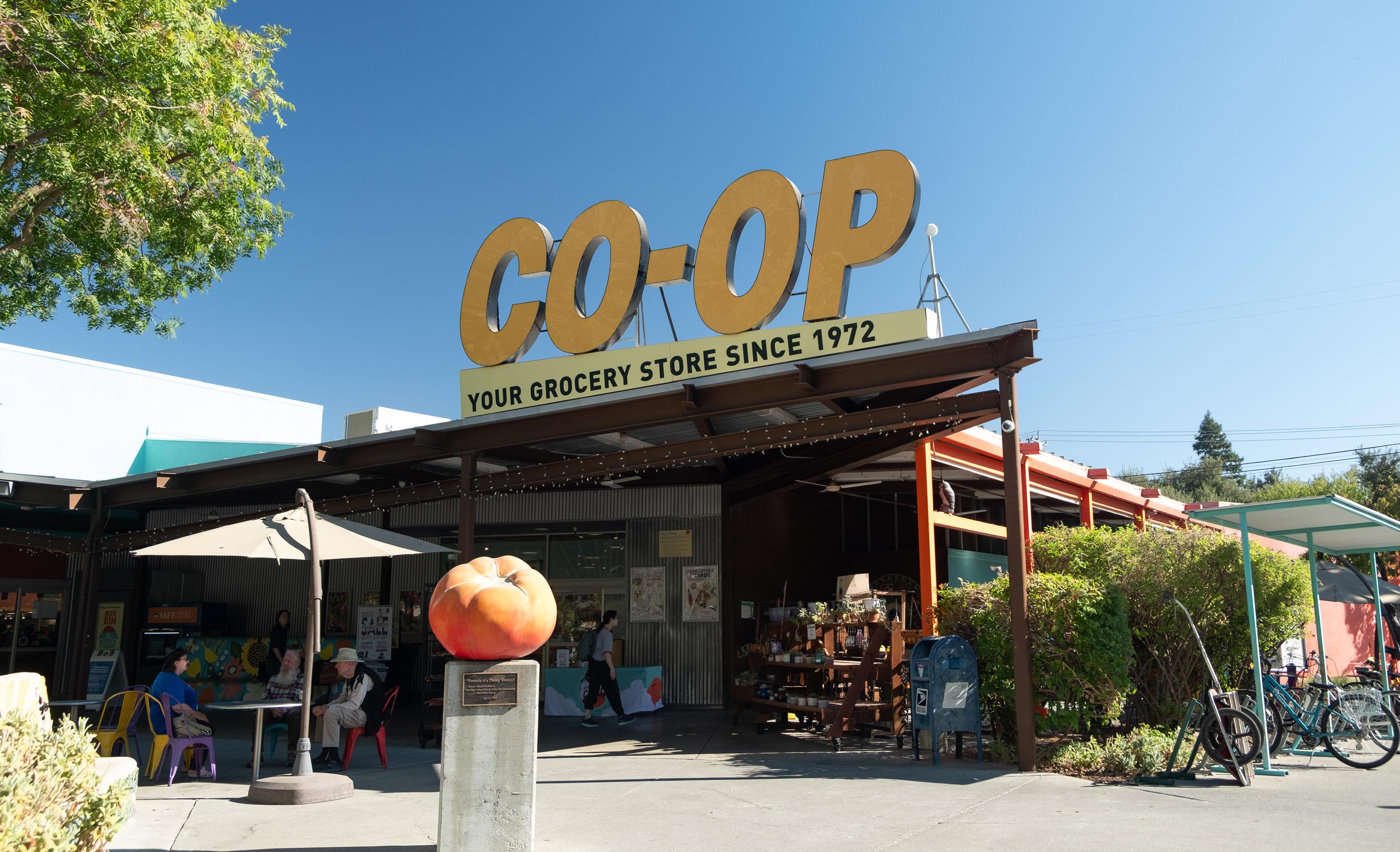
BY OLIVIA HOKR
Hispanic communities. “Sept. 15 was chosen as the starting point for the commemoration of Hispanic Heritage Month as the anniversary of the Cry of Dolores (1810), which marked the start of the Mexican War of Independence,” the website states. “It was this moment that eventually led to independence for the Spanish colonies that are now recognized as the countries of Mexico, Guatemala, El Salvador, Costa Rica, Honduras and Nicaragua. Today we celebrate Hispanic Heritage Month to recognize the achievements and contributions of Hispanic American champions who have inspired others to achieve success.”
Liliana Agredano, the marketing manager of the Davis Co-op, shared the importance of recognizing
diferent ethnicities and identities at a local level. Te co-op creates decorative displays and puts specifc items on sale to spread awareness.
“Typically for these kinds of months we have a display that highlights brands and vendors who are genuinely that ethnicity to highlight them, call them out and try to bring attention to their products,” Agredano said. “On shelf level we have diferent tags that highlight diferent attributes, for example Latino-owned businesses, Asian Pacifc Islanderowned businesses, LGBTQ+-owned businesses.”
During Hispanic Heritage Month, the co-op had the opportunity to host the California Fast Food Union in their teaching kitchen and experience authentic Mexican cuisine.
Additionally, the recipes from staf members are available on their website for everyone to try. Tis year we had a fast food union utilize our teaching kitchen to do an of-site team-bonding experience where they were able to cook diferent cuisines,” Agredano said. “Te lead chef in this experience was from Veracruz, Mexico, so she made her classic Gordas Picadas which was delicious.” Beyond Hispanic Heritage Month, the co-op acknowledges Fair Trade Month and Co-op Month during October. Tey also partner with the National Co-op Grocers organization and Indigenous-led organizations during November to strengthen native foodways.
“For Fair Trade Month and Co-
op Month, which is October, we will be featuring products that are fair trade and highlighting them more,” Agredano said. “We do the same with co-op brands because those are ones that are ethically producing products and ensuring that, one, not only the company is doing well, but mainly focusing on the people on the foregrounds.”
Te Davis Food Co-op is a signifcant local business that takes pride in helping the Davis community, providing healthy options and promoting environmental sustainability. Check out their website and social media for upcoming events and promotions.
First-year and transfer students participated in a variety of activities to help them get oriented with Aggie life
BY RAGAVI GOYAL campus@theaggie.org
From Sep. 17 to 22, transfer and frst-year students were welcomed into the new academic year with Aggie Orientation. Orientation Leaders, assigned to a group of students to guide and teach, led the incoming Aggies through various activities to help them get settled on campus.
For frst-year students, orientation is a three-day program where the new Aggies undergo a variety of workshops, get acquainted with the campus and have the opportunity to connect with other peers through planned events.
Transfer students have a slightly longer orientation that lasts fve days, yet the program consists of many of the same preparation activities.
Many student participants shared positive thoughts about their orientation experience.
“It helped you create that mental map about how UC Davis is, where you can fnd the stuf [and] what you have to do,” Hrithik Tabaki, a frstyear history major, said. “You can ask people what are they doing, what are their classes [and] how they are.”
Orientation activities ranged from mingling, games and city/campus tours to an academic preparation program in which seasoned Aggies gave advice on how to succeed in classes.
One activity called the “Violence Intervention and Prevention Program” hosted by representatives from the Center for Advocacy Resources and Education (CARE) taught the incoming students about the health and safety resources available on campus.
Another popular activity included the “Davisfest Resource Fair,” a tabling event in which students roamed the Quad to explore the various clubs and organizations that the UC Davis community has to ofer.
For both groups of students, orientation ended with a free football game at the UC Davis Health Stadium.
One anonymous student said that they thought the program was very informative.
“Orientation got me used to the surroundings [and] where everything is,” the student said. “I didn’t know more about the university until after the orientation.”
Despite many positive experiences, some students shared unsatisfed opinions about the orientation as well.
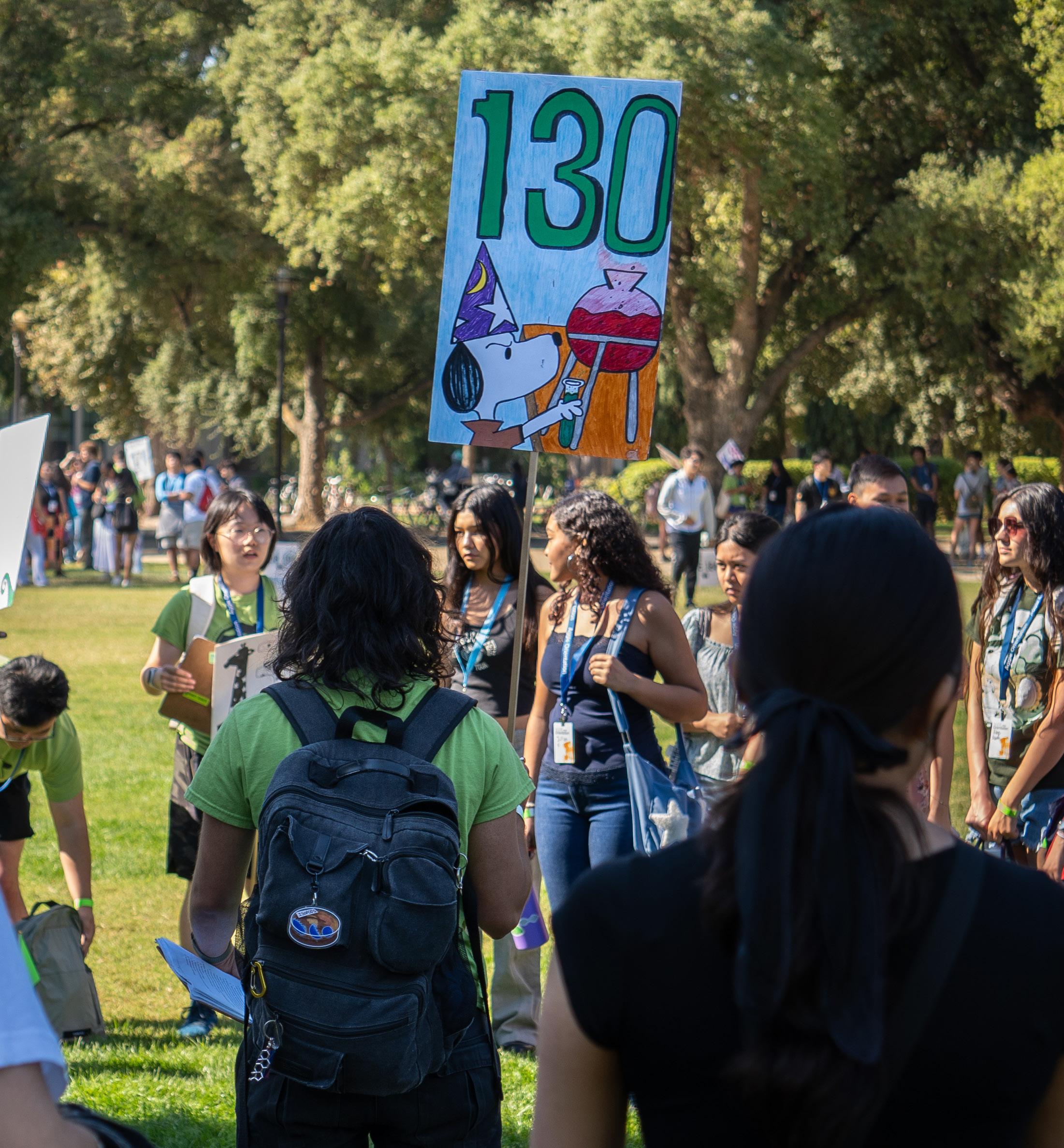
“I mean, the orientation experience [...] was useful to a point,” Jared
a frst-year chemical engineering major, said. “After the frst day, the next two days were kind of repetitive.”
orientation. “Despite its challenges, orientation promotes community,”
The shelter’s dogs and
show off their skills and lovable personality to find their purrfect match

have their pets go on day trips, get toys and receive other forms of enrichment. Tis emphasis on mental well-being as well as physical is something Amato cannot stress enough.
Services provides for pet owners and the community at large.
“Our primary role is public safety, public education and making sure that the animals in our community are taken care of as well,” Amato said. “Animal services is a place where people can fnd their lost pets and help animals fnd new homes. It is also where our feld responders work to handle all kinds of wildlife to ensure the safety of our community.” As a big part of their mission, the shelter provides many important resources for the animals that are rescued or surrendered. Before any pet is ready to be adopted, the shelter ensures they receive vaccines, fea control, medical care and spaying or neutering. And although Amato explained how staf is limited, it is their highest priority for the shelter to
Yolo County Animal Services provides resources for the community’s pet owners as well. Pet owners who have recently adopted are given important necessities such as a harness, toys, food and a packet containing information about pet behavior and resources available to them.
“We really set the new pet parents up with a support system where we can ofer our advice and expertise,” Amato said. “We try to support them with pet food, pet beds and whatever resources they need to keep these pets in their new homes.”
New and old pet parents alike can beneft as the shelter is excited to be hosting their frst free vaccine and microchip clinic on Oct. 5. Further information about the resources provided by Yolo County Animal Services and any upcoming events can
be accessed on their ofcial website.
Tricia Hilliard is the co-founder of Friends of Yolo County Animal Services, the organization that sponsors a lot of the adoption events that happen all throughout Yolo County, including the June 4 kitten adoption event that happened in Davis at Phi Delta Teta.
“Our mission, really, is twofold,” Hilliard said. “It is to get the community involved to take a look at our dogs and reach out to volunteers.”
Te events they host are also meant to encourage the donations of pet supplies and monetary contributions for the shelter as they anticipate major renovations. On top of the supplies being useful for the
to fnd more animal lovers willing to dedicate a few hours in their schedule to help walk the shelter’s evergrowing pet population. Regardless of experience, they would love to take on and train volunteers to help out around the shelter. Volunteer shifts tend to last around three hours and are available from as early as 8 a.m. to 5 p.m. at the latest. Further information on how to apply is available on the Friends of the Yolo County Animal Services website.
“Even if you can’t adopt, volunteer or donate, the best thing to do is to be educated about what we do here because it is not all doom and gloom,” Amato said. “Tere’s a lot more that we give back to the community, and there’s also a lot more around the corner as we hope to host more events throughout the county.”
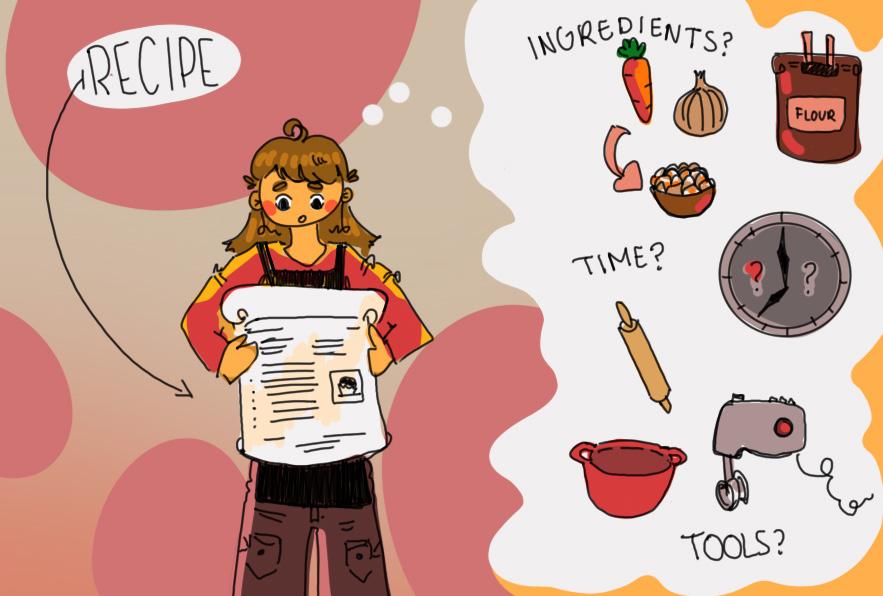
BY MAYA KORNYEYEVA mkornyeyeva@ucdavis.edu
It’s the start of another fall quarter — a time flled with optimism, a little bit of nerves and a palpable sense of excitement. A new school year also means a new you; it’s a chance to make friends, go to some school-wide events, tweak your style and start your classes strong. It’s your moment to get back into the academic groove and get a feel for everything UC Davis has to ofer.
If you’re an of-campus apartment dweller like me, it also means a fresh start to plan out your schedule for the next three months, especially when it comes to food. When I moved out of the dorms last year, it was quite a daunting prospect to be at my own discretion to purchase ingredients and scavenge for good college meal recommendations. It proved challenging to fnd recipes that didn’t require a lot of expensive ingredients, and even harder to make sure I did
every step of the recipe right. Over the last year, I’ve learned a tremendous amount about how to properly read a recipe and what the best recipe formats look like. Here are some of my tips to help you along as you start chefng-it-up this quarter.
How to properly read a recipe:
1. Read the entire recipe from start to fnish, taking note of the ingredients and any prep work that needs to be done. Plenty of recipes will be marketed as “15 to 30-minute quick meals” when, in fact, they assume that you’ve already done a good amount of prep work. Look for anything that is already “pre-made” like crust, puf pastry, chopped veggies or marinated meat and prepare it in advance.
2. Mentally gauge the time the recipe will take you. Not everyone is a speedy cook (I am defnitely not), so remember to keep your own skill level in mind when approaching a recipe. Make sure to account for “waiting time,” which includes the time that it takes to preheat the oven, refrigerate
your dish or bring ingredients to room temperature (such as butter or eggs).
I’ve found that it takes me roughly 20 minutes longer than the estimated time shown on the recipe: give yourself space to problem-solve any issues without feeling pressured for time.
3. Ensure you have the tools and ingredients necessary. Cooking is very precise, so recipes are often based on the assumption that you have all the measuring equipment, pots, pans and culinary tools at your disposal. While reading the recipe through for the frst time, make sure to think about what items you will need to help you cook — whether it’s a spatula, sieve, zester, mixer or rolling pin.
4. Don’t panic if you’re an ingredient short — there are often plenty of options for substitute ingredients to use instead. A few common ones include lemon juice or vinegar instead of buttermilk and margarine or oil instead of butter. Spice mixes don’t have to be precise either; I’ve found that it’s rather fun to blend my own concoction of spices for
a meal and try out some new favors, especially if I’m only missing a few from the original recipe.
Te best recipes have…
1. A list of tools alongside a list of ingredients. Tese are always the clearest and simplest recipes to follow.
2. Batched proportions. Let’s say you are looking at a cookie recipe to satisfy your post-exam cravings. Te most straightforward recipes have tabs with ingredient proportions for half batches (12 cookies), regular batches (24 cookies), double batches (48 cookies) and so on. Tis allows you to skip a whole bunch of complicated math when it comes to doubling or halving the amounts of ingredients you need.
3. An estimated “end amount,” i.e. how many people the recipe is good for. As an example, if you’re planning to bring a pan of mac and cheese over for a friend’s potluck, you may want to look for a recipe that “feeds 8-10 people” rather than a recipe that includes no indication of how much
mac and cheese you’ll actually end up with. Tat way, you can search and plan your dish accordingly.
4. Step-by-step photos or videos. Te most beginner-friendly recipes walk you through each step of the process, teaching you what order to mix ingredients and showing you what each phase of the recipe should look like. Tis is extremely helpful when you are new to cooking and need a little extra guidance, allowing you to match the written description in the recipe to a visual image.
So, there you have it. Tese are some of my biggest takeaways from cooking for myself last school year, and I hope they prove useful to anyone out there that is new to cooking. Here’s to always fnding practical and delicious recipes that make living and cooking by yourself a bit less overwhelming.
Disclaimer: Te views and opinions expressed by individual columnists belong to the columnists alone and do not necessarily indicate the views and
Sign now!
BY AUDREY ZHANG aurzhang@ucdavis.edu
When was the last time you’ve been inside a monument to human engineering? When was the last time you saw colors that clashed so horribly they made the presidential debate look like a loving embrace? When have we as
a society lost our sense of whimsy? Ever since the dawn of history, people have longed to touch the sky. Babylon. Te Wright brothers. Jef Bezos trying to get all of the billionaires of of the planet.
It was because he knew that somewhere out there in the universe was a place where people could bounce freely to their heart’s content. Te phrase “jumping for joy” exists for a reason. UC Davis may talk a big
game about caring for their students’ mental health, but they won’t provide for their most basic emotional needs. Studies show that 100% of Americans are sufering from orbital defciencies, ever since bouncy castles were monopolized by selfsh parents who only let children use them at birthday parties and subpar state fairs.
“It’s not enough to get the university to build the bouncy castle,” a leading
orbital specialist said. “It is crucial to also fght to get small children into the new bouncy house, so that students can jump as hard as they can and send the tots fying.”
When asked how many children doctors recommend sending into orbit, they said, “At least three per day.”
It’s not like there’s anything useful in the Memorial Union anyway. Let’s be serious, a games lounge? What are
we, fve? We need our infatable bouncy castle and we need it now.
Disclaimer: (Tis article is humor and/or satire, and its content is purely fctional. Te story and the names of “sources” are fctionalized.)
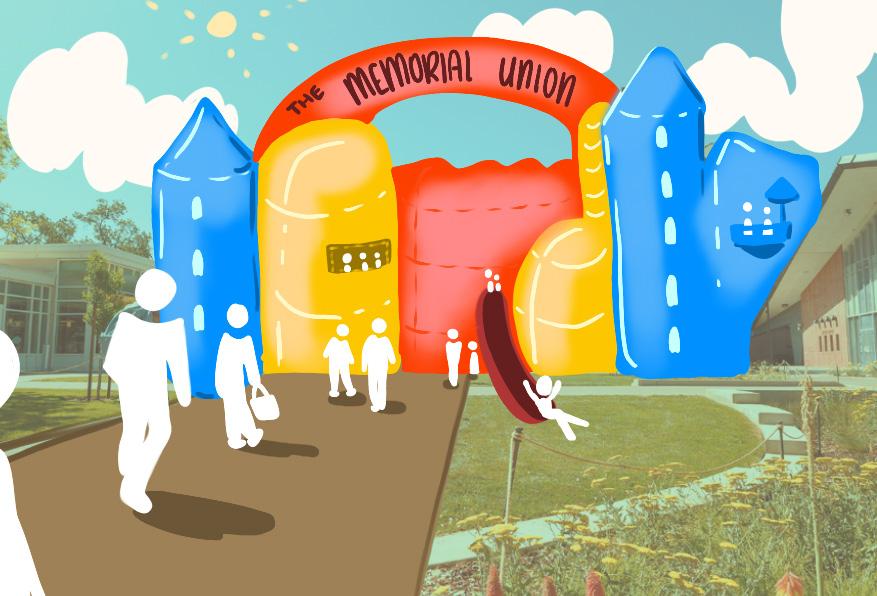
Student activists deserve respect, privacy and safety
WRITTEN BY THE EDITORIAL BOARD
Deeply rooted within university culture is the student body’s right to free speech and self-expression. At UC Davis, it is not entirely uncommon to see student groups marching with signs across campus or Eggheads spray-painted with grafti in protest of the university’s actions. As we enter a new academic year, the Editorial Board wants to recognize the importance of youth activism and the right to freedom of speech on college campuses.
Protests can spread awareness on harmful policies, draw attention to dangerous political movements and spearhead change. Specifcally, student activism has often acted as a catalyst for social progress — empowering those both inside and outside of the university. From workers’ strikes to the pro-Palestine encampments to the Vietnam War, UC Davis students have never shied away from speaking out on
Scan to read our online editorial about wellness EDITORIAL
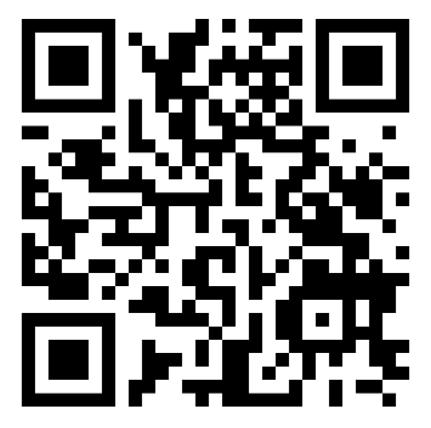
current events.
Over the summer, University of California President Michael V. Drake announced new rules and regulations regarding protests for all 10 UC campuses. Tese changes were announced following the UC-wide encampments erected in support of the Free Palestine movement, where pro-Palestine students set up tents in the central campus in protest of the UC’s fnancial relationship with Israel.
While it is clear that these changes to protest policy on campus were made in response to the encampments, one of the most notable changes is the increased regulation of face coverings.
“Individuals may not wear a mask, personal disguise or otherwise conceal their identity with the intent to intimidate any person or group, or to evade or escape discovery, recognition or identifcation while violating law or policy,” according to the UC Davis website.
Along with religious coverings, cultural coverings like the Kefyeh, a traditional Palestinian scarf, can be worn on the face and head.
Additionally, students wearing face masks to prevent the spread of COVID-19, especially for immunocompromised or otherwise at-risk individuals, would be required to remove the covering if campus authorities determined ill intent.
“No person on university property may refuse to identify themselves when requested by a university ofcial who is performing their duties in situations that require assistance or intervention,” according to the website.
Te vague and confusing methodology for determining what face coverings are permissible and which are not can only lead to negative impacts on student safety and privacy.
UC Davis simultaneously supports
the use of masks during protests for health precautions and condemns the use of masks in any way that the UC does not permit. A set of rules that are subject simply to the opinions of campus ofcials are based on belief, not fact, and can only create a biased enforcement of rules that harms rather than protects.
Other aspects of protesting are not permitted — such as restricting free movement and placing unauthorized structures — but non-disruptive protests and freedom of speech as a whole are encouraged by UC Davis. Te issue, however, comes with expecting protests to always be quiet, passive and complacent, when in reality protests are inherently meant to challenge and confront.
Te UC’s ofcial rhetoric surrounding student protestors depicts activists as violent and disruptive, and the requirements for engaging in a protest or demonstration follow this trend. By placing unreasonable demands, the students’ right to free speech is called into question. A protest that does not interrupt daily proceedings and that requires students to remove protective, cultural or religious facial coverings for fear of university retaliation is both inefective and dangerous.
As students part of a large public university, we have the unique opportunity to become educated on current events and stay connected to each other. Now more than ever, it is important to acknowledge the positive impact that university protests have had globally. We encourage new and old students to remain educated on current issues, listen to each other and become active and involved members of the community. Young activists are passionate and determined and deserve the right to express themselves — both safely and freely.
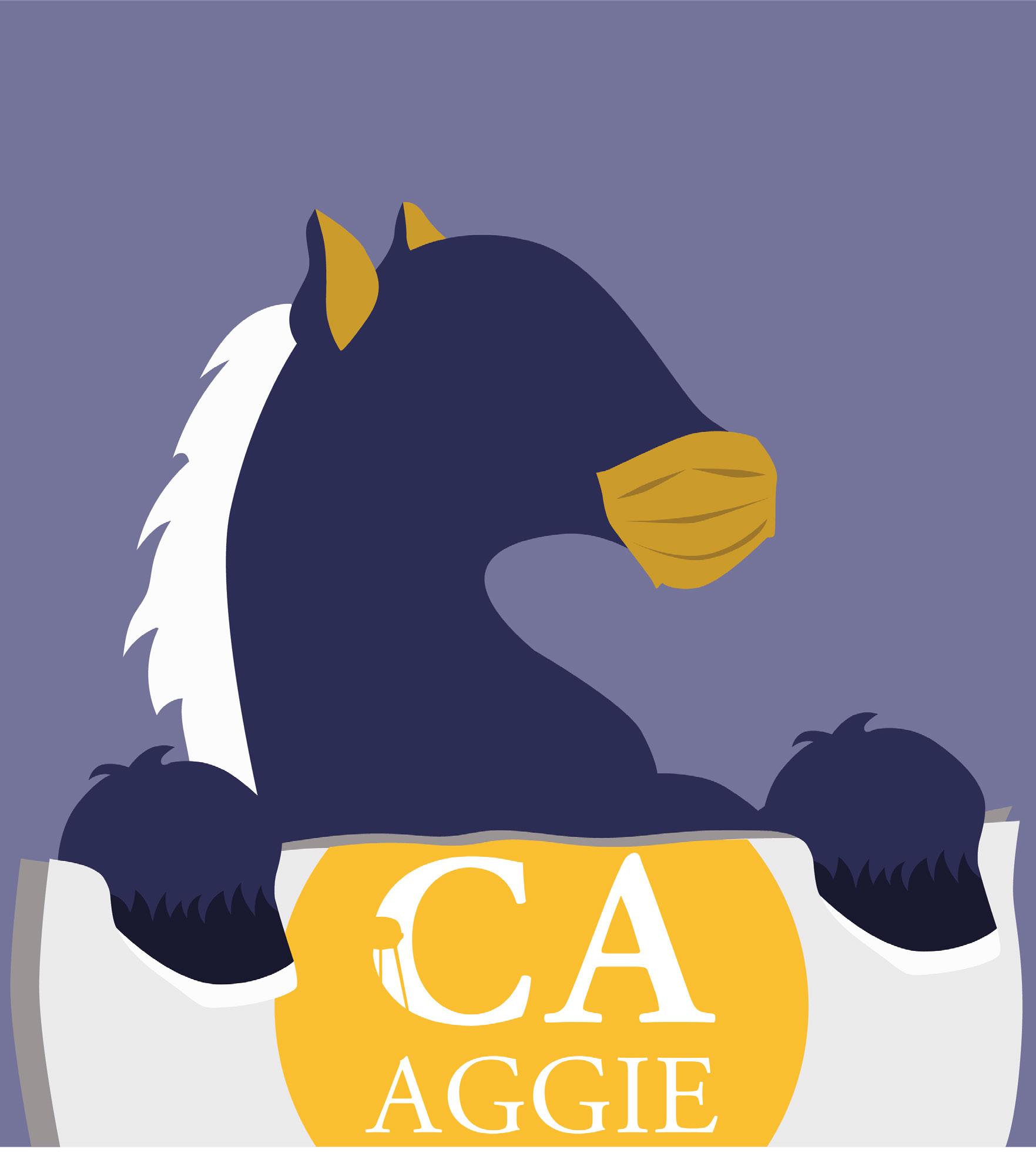



Editorial Board
CHRIS PONCE Editor-in-Chief
ALYSSA CREVOISERAT Managing Editor
MADISON PETERS Campus News Editor
HANNAH SCHRADER City News Editor
MAYA KORNYEYEVA Opinion Editor
ZOEY MORTAZAVI Features Editor
ANA BACH Arts & Culture Editor
MEGAN JOSEPH Sports Editor
KATIE HELLMAN Science Editor
JENNA LEE Photo Director
ARIANA NOBLE Layout Director
LANHUI ZHEN Design Director
JOANNE SUN Social Media Manager
AARON POTTER Website Manager
CASSIDY GILLIS Distribution & Outreach Director
TIFFANY HE Copy Chief
JENNY DYE Copy Chief
SAMUEL RUIZ Translation Director
ILEANA MERAZ Translation Director
LAURIE PEDERSON Business Development Manager
Hispanic Heritage Month
BY CHRIS PONCE editor@theaggie.org
Dear Reader,
Happy Hispanic Heritage Month!
Tis month, I’d like to provide you with some of my background and story.
I am a third-generation Chicano from Southern California. My parents were born near East Los Angeles and I’ve spent most of my life growing up in a small desert town. Coming to Northern California was the biggest culture shock of my life. It felt like I had traveled to a new world that looked very little like my home.
Tankfully, in my time here, I’ve found my people and I’ve found my home again — but it took more work than I had anticipated. While it’s the name of the month, I’ve never used the term “Hispanic” to describe myself. I don’t have an issue with anyone in our community choosing to identify this way, it just simply is not the word for me.
I’ve asked friends and loved ones what they prefer to be called, and I get mixed answers; Mexican, Latino, Mexican-American — the list goes on. I am all of these labels and all of these labels are me, but the one I’ve always held closest to my heart was



When I discovered the Chicano Movement as a kid I felt empowered to see a community with stories similar to mine, I felt empowered to see a community born in protest and action. I remember discovering a photo from the movement of a rally sign that read “Chicano means power.” Te legacy of those words are what inspire me everyday.
As I step into this position as Editor-in-Chief and continue working in journalism, I carry the pride of my people with me. Journalism, like all felds, is only improved by diversity — this means diversity in the stories we cover, the diversity in perspectives we hold and diversity in our workplace. I am honored to help represent that in some way. While I still struggle to fnd the balance between being a Mexican journalist and a journalist who is Mexican, I take pride in my culture and understand the signifcance it means being in a leadership position. So this Hispanic Heritage Month I encourage you to educate yourself not just on the history of Latinos but the day-to-day struggles that are our reality. Educate yourself on the conditions farmworkers are living in today and how migrant children are often still used for labor in the felds. Educate yourself on the systematic barriers that still exist today and pay attention to how your ballot afects us.
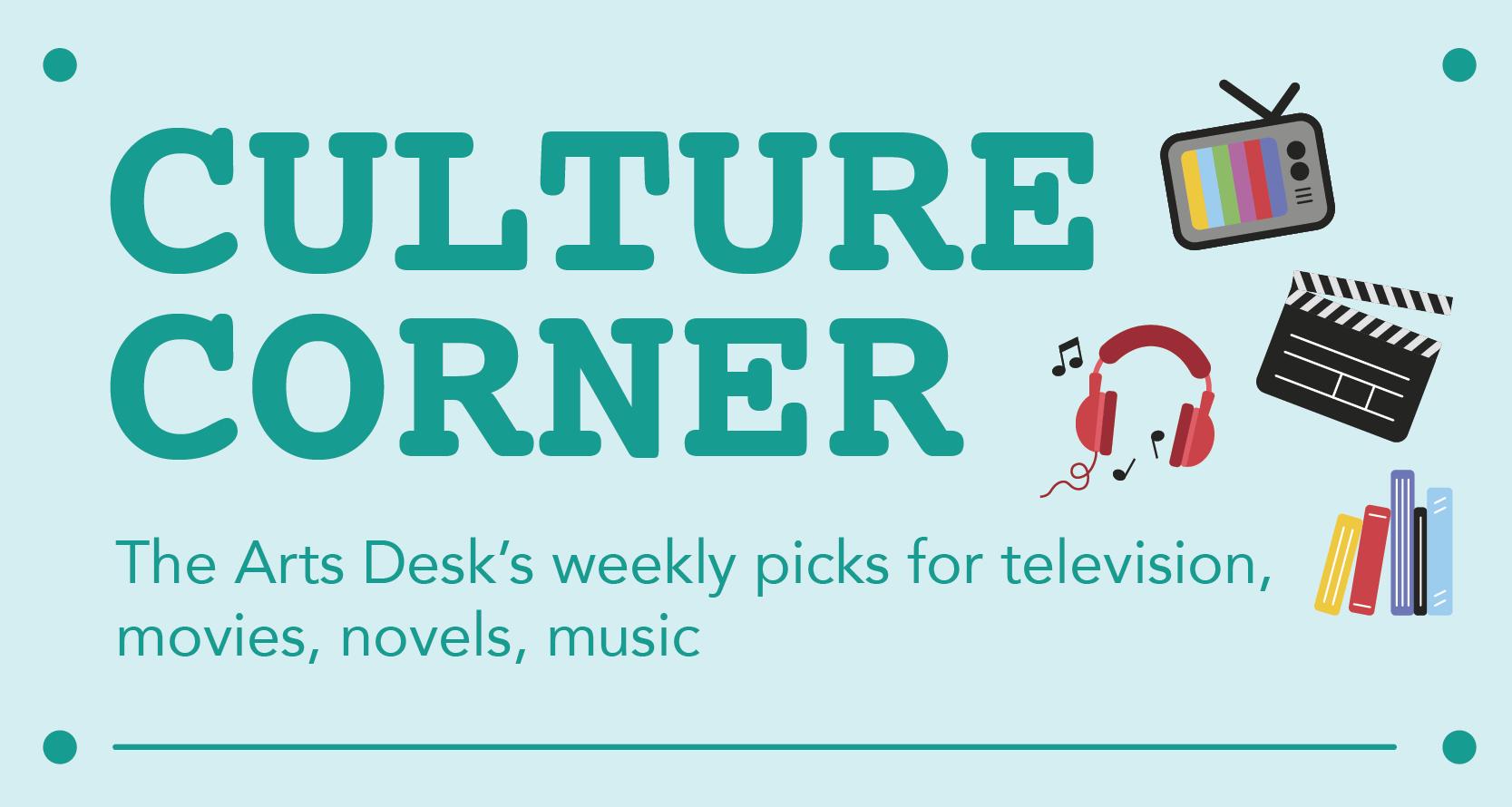
BY AALIYAH ESPAÑOL-RIVAS arts@theaggie.org
Song: “Pushing It Down and Praying” by Lizzy McAlpine (2024)



Lizzy McAlpine has killed me once again with the song “Pushing It Down and Praying.” Te lead single of of her deluxe album, “Older (and Wiser),” explores the tumultuous relationship of two individuals whose relationship is only being held together by intimacy. Te song opens with a depiction of an intimate moment shared between the artist and her partner, with the accompanying melancholic melody, as McAlpine questions her partner’s love for her. Troughout the song, McAlpine alternates from thinking she loves him while still wanting more from someone. Te song is raw, with an overall feeling of defeat. While McAlpine may want something more, she’s pushing that feeling away and praying it all works out.
Book: “Picking Daisies on Sundays” by Liana Cincotti (2023)
In the same realm of books such as “To All the Boys I’ve Loved Before” and “Better Tan the Movies,” the book “Picking Daisies on Sundays” by Liana Cincotti is a perfect pick for those who love the childhood friends to lovers trope, fake dating and golden retriever boys. Te book follows Daniela, otherwise known as Daisy, a college student in New York who dreams of becoming a fashion designer and deep down yearns for romance. However, after getting rejected by her boy best friend, Levi, in high school, Daisy continues to face challenges in the dating scene. Tat is, until she ends up running into Levi at a bar four years after he rejected her. He proposes for her to fake date him, leaving Daisy thinking: maybe all hope isn’t lost with Levi.
TV Show: “Big Brother” by John de. Mol (2000)
Do you ever feel like you’re being watched? Well, if you’re on the reality show “Big Brother,” your fears can become a reality. With 100 cameras and microphones following their every move 24/7, “Big Brother” follows 16 contestants, or houseguests, as they compete week after week for $750,000 in a house that they cannot escape. Te show has produced seasons every summer since 2000. Akin to “Survivor” (minus the grueling outdoor environment), houseguests face challenges that test their math skills, endurance and memory as they attempt to stay of “the block” to avoid eviction. Mixed with heightened emotions, secret alliances and twists that can blow up the entire game in one second, you always have to expect the unexpected. While the current season is still airing on CBS, be sure to tune in to catch the last four houseguests remaining.
Movie: “Teater Camp” dir. by Molly Gordon and Nick Lieberman (2023)
Any theater kids out there? No…?

Te flm “Teater Camp” is exactly what the title implies — “theater” and “camp.” In a mockumentary-style flm following a struggling theater camp, counselors Amos (Ben Platt) and Rebecca-Diane (Molly Gordon) attempt to keep the camp afoat amidst a plethora of problems while trying to prepare the campers for the fnal performance. Filled with drama between counselors, a replacement owner who knows more about being an infuencer than theater and a musical sequence of kids singing as pieces of cocaine going into a papermache nose, the flm is every theater kid’s worst nightmare and dream.
In honor of Hispanic Heritage Month here is a joke in Spanish from our translation team
Había una vez un tenedor caminando en la calle,
Tenía muy pendiente a su amiga de siempre, la cuchara
Mientras caminaba vio una fgura que se parecía mucho a la dichosa cuchara hablando con la dona de un restaurante
Esta f gura, aunque no lo sabía el tenedor, era un cuchillo
Le empieza a gritar, -¡CUCHARA! ¡CUCHARA!Y como lo le contestó la f gura el tenedor se confundió, y pensó
¡Ah caray, parece que no es cuchara!
UC Davis alumni Thea Hudson and Genevieve Ryan share the thought process behind their first joint exhibition, “Friends are Everywhere”

about Ryan.
BY SAVANNAH ANNO arts@theaggie.org
From Sept. 4 to 28, visitors of the John Natsoulas Gallery were given the opportunity to explore “Friends are Everywhere,” a new exhibition by best friends Tea Hudson and Genevieve Ryan. Located on the second foor of the gallery, the month-long exhibition included paintings, graphite drawings and various mixed media pieces from the UC Davis alumni. With each artwork depicting at least two fgures — usually dancing, holding hands or making music — it would have been impossible to experience Hudson and Ryan’s exhibition without thinking of your own partners in life, whether it’s an old friend you miss or a sister you just spoke with recently.
Working to explore the complexities of friendship, Hudson and Ryan discussed not only the joy that platonic love brings but how one grapples with the inevitable loss of that connection.
“A very beloved friend of mine passed in 2022, and much of my art is born from my grief and refections on friendship, life and loss,” Ryan said via email. “Yet in this grief, there’s a profound vividness to life. A friend who is no longer here is present in the trees, in the sky, in the light.”
Translated into Ryan’s graphite drawings, black-and-white depictions that may at first feel somber are transformed by interactions between the fgures within. Sometimes appearing to be on diferent planes, with some figures shaded and others startling white in drawings like “Horses,” they are connected nonetheless as they move in the same directions and reach for the same things.
With pieces like “Arils” and “Reaching,” Ryan creates vivid and mystical depictions of nature — a red stained glass pomegranate hangs in the gallery window, and friends lift their arms up toward a plant that dissolves into a bright white sky.
“I love Genevieve’s art so much,” Hudson said. “I can’t even pick a favorite. However, her stained glass pomegranate with the little babies in it is so beautiful.”
On the other side of the exhibition, Hudson’s work celebrates the simple, yet essential, pleasure of company through bright and whimsical beings. Folkloric fgures dance together in her colorful “Maypole,” while a dreamy trio of vampires rest in a feld of pink fowers together in Hudson’s “Vampires in Springtime.”
“When I close my eyes, sometimes I see the colors of Tea’s springtime vampires and the afterglow of the image lingers in my mind’s eye,” Ryan said. “I love it, all her work is so imaginative, it makes me feel like I’m seeing fairytales come to life.”
“Vampires are used to represent a lot of things,” Hudson said. “To me, vampires are hungry, undergoing semiviolent rebirth, clawing their way out of the soil like fowers. Feeling the creative drive after a dead period [as an artist] feels like that. Lady vampires in particular are often represented in groups, so for me [the piece] is an expression of creative partnership.”
Perhaps a reference to their own friendship, Hudson and Ryan — like the springtime vampires — thrive and grow as a result of each other’s presence. Inspired by one another on both a professional and personal level, the best friends hold a unique appreciation and reverence for each other.
Tea is like a holy center of the creative process,” Ryan said.
In response to this description of her, Hudson said she feels the same way
“She’s like the high priestess of art,” Hudson said.
Hudson, who has been working with the Natsoulas Gallery since 2022 as a graphic designer, was given the opportunity to create an exhibition by owner John Natsoulas after her work with the Davis Mural Team. Designing the mural “La Blessure” in 2023 — located behind the downtown Davis post ofce on D Street — and working closely with Ryan throughout the process, Hudson explains the birth of “Friends are Everywhere” began there.
“We believe that when the universe was formed, our meeting was already present in the fabric of existence,” Ryan said. “From there we’ve just come to understand how cosmically right it is for us to be together.”
Both UC Davis alumni also refected on their experience as students and what most prepared them for the creation of the exhibition.
“I learned some exhibition design at UC Davis, but most of my experience came from doing design work for other artists’ shows at the [Natsoulas] gallery,” Hudson said.
Additionally, Hudson suggests that artists looking to install their own exhibitions in the future shouldn’t confne themselves to a traditional gallery space in order to gain experience.
“Genevieve let me install an exhibition with homemade labels and wall text in our apartment last year, which gave me a lot of experience making a cohesive body of work,” Hudson said. “I wouldn’t have been prepared for this exhibition otherwise.”
Having to create a space where each piece complements the others around it, especially when it features two artists with diferent visual styles, can be a challenge. For Hudson and Ryan, the grueling experience made them more excited for what the future has in store.
“It was ruthless,” Ryan said. “Tere was a tight deadline and we both had a lot of concepts that we had to discard on the fy, but our discarded ideas are now seeds sown for future exhibitions we want to do together.” One idea that did stick, however, was Hudson’s “New Friends Birdie Game,” an interactive piece that encourages visitors to sit with one another and play. A large painting framed by sculpted faces, the game uses a projector to create glowing silhouettes of plants and two characters that visitors can move around as they hear a singing chorus.
“[Te game] is some version of an operatic, interactive painting-sculpture that has been lingering in the back of my mind since I was 12,” Hudson said. “To see it realized and to see people enjoy it is the best feeling. I loved sitting close to the installation and hearing diferent ages of people fgure out how to play.”
As the pair refect on the long journey of creating “Friends are Everywhere,” both Hudson and Ryan afrm that the greatest feeling has been seeing guests resonate with their art. With both artists tugging on the heartstrings of anyone who understands what it feels like to have a partner — a friend, a mother, a sister — this past month, “Friends are Everywhere” proved to be a universally understood truth.
“It’s a wonderful feeling knowing that your work has touched something inside another person,” Ryan said. “I think in both of our artwork, there’s a sense of life in everything. Tat’s how we came to the idea of our exhibition title; I really believe friends are everywhere, in everything.”
BY JULIE HUANG arts@theaggie.org
Perfumery has been around since antiquity, and it is not going away anytime soon. Te personal care and cosmetics industry and its consumers are always fnding new ways to engage with scented products, whether through perfume, body mists, body washes, candles or a combination of each.
Recently, the idea of consciously emphasizing specifc scents through personal care products has been gaining in popularity as online creators on platforms like TikTok and YouTube curate hygiene routines. Featuring shower care, lotions, deodorants, body mists and perfumes that are all meant to complement and enhance each other’s scent performance, these assortments of products are designed to allow wearers to radiate a scent of their choosing.
Popular scent choices include vanilla, coconut, forals, a myriad of diferent fruity fragrances and just about anything that smells good.
Khadydiatou Ndiaye, a secondyear linguistics major, pointed out the age-old wisdom in choosing a traditionally popular scent.
Tere are certain scents that just attract most people, like vanilla or shea butter,” Ndiaye said.
When wearing a more conventional fragrance, the social aspect of scented care is able to take the spotlight and create opportunities for connection and confdence boosting.
“You know that you smell good when you go outside and people give you compliments,” Ndiaye said. “You just feel some type of confdence, like it boosts your ego.”
However, layering diferent scents is another great option that can help you fnd more creative freedom in cultivating your own personal scent.
Te idea of using fragrance to diferentiate oneself from the crowd is a key aspect of scented care. Consistently sporting a chosen scent becomes not just a personal preference but also a means of nonverbal communication to others regarding one’s presence and identity.
“If somebody walks by me, they’re going to be like, ‘Oh, Khadyjia’s here,” Ndiaye said. “My scent is like a signature.”
Scent also provides a form of sensory stimulation that can afect one’s mood as well as the mood of people nearby, often adding depth and character to the surrounding environment.

LANHUI ZHEN / AGGIE
Lily Hatch, a second-year art studio major, often uses scented candles to bring a positive atmosphere to her personal space.
“Lighting candles helps set the tone for the room and the vibe, and it kind of calms you down,” Hatch said. Other forms of scented products, such as body mists and perfumes, subtly enhance diferent aspects of
daily life by providing chances to play around and experiment with pairing seemingly unrelated items.
“I will choose [my scent] based on if it fts my outft, or if I’m wearing sunscreen that smells kind of like vanilla, I’ll spray something that complements it,” Hatch said.
Jessica Alvarez-Cruz, a second-year chemistry major, noted that the mere
act of choosing to wear a fragrance makes a statement in itself.
“Whether they thought about the way they wanted to smell or they just put something random on, what someone smells like can defnitely say a lot about that person,” Alvarez-Cruz said.
Useful for creating positive sensory experiences, fragrance simultaneously
functions as a form of communication, exploration and personal expression. Whether you notice it or not, adding scented products into your daily routine is truly one of the most rewarding forms of self-care that we can do for ourselves.
Famous art pieces by Salvador Dalí, Francis Bacon and others on display for the first time in decades
BY NOAH HARRIS features@theaggie.org
On Sept. 26, hundreds of people gathered at our local museum to view two new art exhibitions that opened the previous week. Works from famous artists are currently showing that have not been displayed in a gallery setting in decades. In addition, a ceramic exhibit is currently showcasing the history and culture of those who created it. While displays like these are usually found in large museums in big cities, the Manetti Shrem Museum on the UC Davis campus has the honor of hosting these recent exhibits. Preparing for what the museum says will be “an extraordinary fall season,” the fall season celebration aimed to bring the community together to celebrate new pieces on display. Tere was a catering staf, games for children to play and plenty of space to draw. While the event in its entirety lasted from 10 a.m. to 5 p.m., the main part of the festivities occurred between 12 and 4 p.m. During this time, a Q&A was held with the curators of two exhibitions, including four students
who helped create an exhibition titled “Light into Density.”
Te exhibit opened to the public on Sept. 19 and will be on display until May 5, 2025. Tis exhibit is a frst for the museum, as it is the frst student-curated and student-designed exhibition. In total, there were 32 students involved in the curation and design of the exhibit; with the names and pictures of those students being showcased as well.
Te art itself was very well-received by the public. Featured works are from artists such as Salvador Dalí, Vassily Kandinsky, Joan Miró and Francis Bacon. Tere are only 15 pieces, many of which have not been viewed in public for decades, according to the museum. All works in this exhibit are from the personal collection of Jan Shrem and Maria Manetti Shrem, the namesakes of the building.
Students did not know prior to enrolling in the class during the fall of 2023 that they were going to be curators and designers for this exhibit.
Te course, Art History 102: Exhibition Practicum, was supposed to have 15 people.
“Tere was an administrative snafu, so there were actually 30 students
enrolled, and then a waitlist of almost 30,” Alexandra Sofroniew, the instructor of the course, said. “I took as many people as I could.”
Te name of the exhibit came from a painting by the same name from Antony Tapies. Sofroniew, who is also an assistant professor in the art history and classics department at UC Davis, explained how the students chose the name “Light into Density.”
“A lot of the paintings are sort of trauma informed and can be quite dark [but] students found hope in the painting,” Sofroniew said. “Tat particular piece encapsulated the idea that there’s some darkness in these works, but that there’s also a lot of light and hope.”
As part of the Q&A, four student curators took questions from the audience and described their work. Tey were Kelly Kankowski, a fourth-year design major, Maev Dunning, a UC Davis alum who now works for Manetti Shrem, Madeline Furtado, a fourth-year art history and design double major, and Morgan Strong, a third-year art studio and design double major.
Kankowski still seemed a little surprised that the exhibit was happening.
“I was honestly shocked — I joined the class on a whim [and] did not expect to be part of an actual exhibit that was going to be at the Manetti Shrem Museum,” Kanowski said.
Strong spent months on the waitlist before she fnally was admitted into the class.
Tere were a lot of people in the class, and [Sofroniew] was trying to scare away people nicely, and I was sitting there going, ‘Leave, I need to get in this class,’” Strong said.
While working with 32 people might make it hard to collaborate, Dunning noted that the process went smoothly.
“Everyone was really excited about it and motivated about it, which I think made all the diference,” Dunning said.
Te art pieces used were set in stone, so for Furtado, the most important part of the exhibition was the guest experience.
“A lot of the artworks were predetermined,” Furtado said. “Our main thing was amplifying visitor interpretation for this space.”
Another exhibition that opened on Sept. 19 features ceramic works by the San Francisco-based artists Cathy
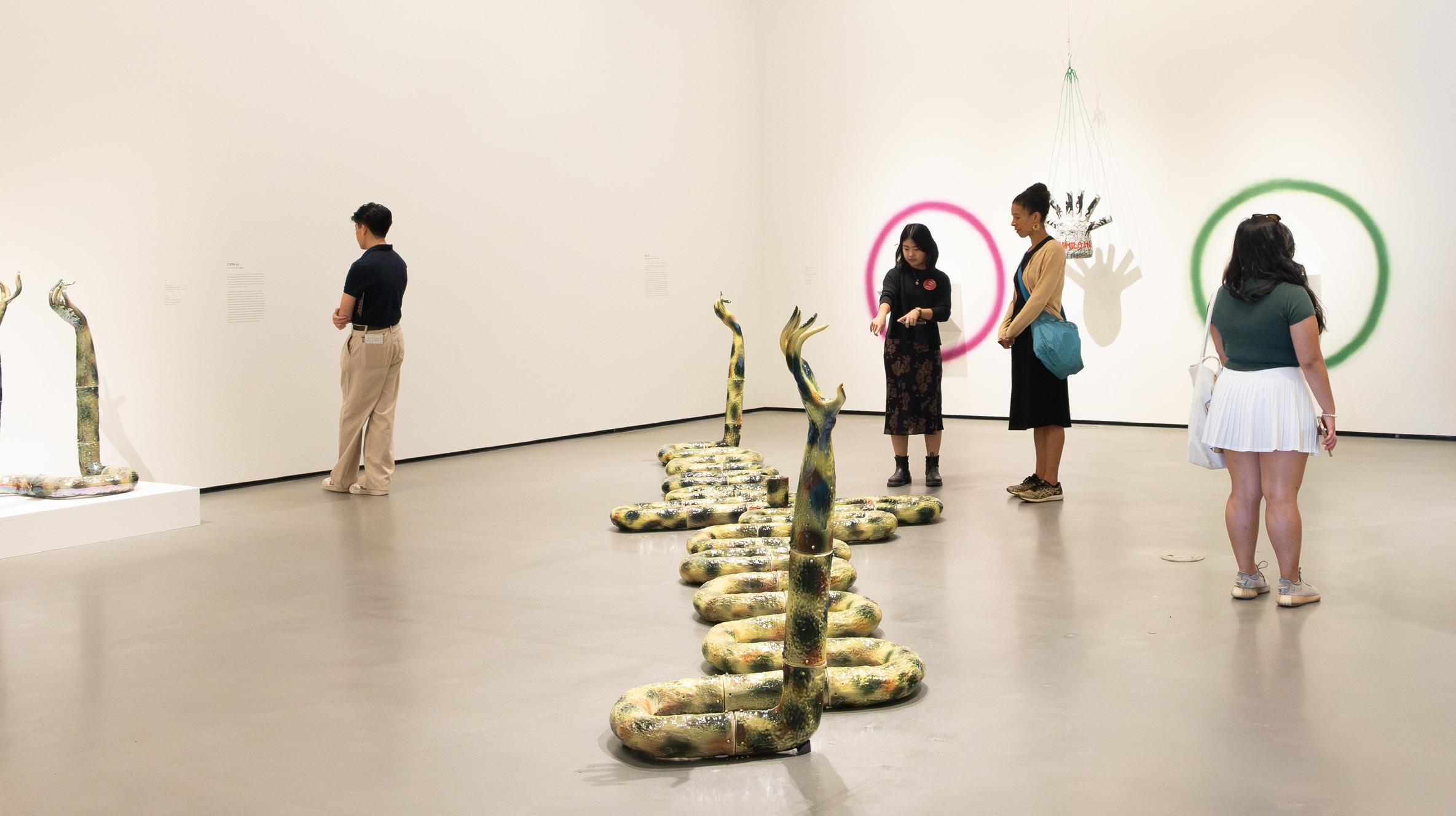
Lu, Paz G and Maryam Yousif. Titled “Ritual Clay,” the works share a theme of past cultures as conduits of cultural knowledge.
The meanings of many art exhibitions can be confusing to interpret. Ginny Duncan, the curatorial assistant at the Manetti Shrem Museum and curator of “Ritual Clay,” described what the name of their exhibit means.
“‘Ritual Clay’ comes from the idea that I’m bringing together three artists that are working in ceramics — that would be the clay piece of ritual clay — [and] they’re using clay as a way to reach back to their stories, or [the ritual],” Duncan said.
Duncan also explained how the art exhibition came into existence.
“It came out of conversations with all three artists,” Duncan said. “I realized that there was a deeper thread that connected the three of them, and that they were working with clay for a similar purpose and accessing this cultural knowledge that’s diferent for each of them. It was realizing that all three of them were thinking about similar themes, even though they were approaching [them] in diferent ways.” Duncan was also excited about the displays on show. Te exhibit features ceramics of all shapes and sizes with vivid, bold colors.
“Hopefully people will be drawn in by the range of sculptures on show,” Duncan said. “They all look very diferent; they are, in their own ways, very impressive.”
A third exhibit has been open since Aug. 8, titled “Entangled Writing.” Its sculptures explore themes of immigration, ethnicity, race and gender in 21st century America. It is also said to be “the largest group of works the Manetti Shrem Museum has commissioned at one time.”
If there is no other reason to go see these exhibits, Sofroniew suggests a compelling one.
“A Salvador Dalí is going to [be] hanging here on campus, you can see it for free until May,” Sofroniew said.
“Everyone should come see it.”
The Manetti Shrem Museum seems to be a fitting home for all types of art. UC Davis students and staf are recommending that members of this community take advantage of the museum as a resource, as well as a place to appreciate student and staf collaboration and culture.
These grants fund research for programs such as social work and psychology studies
BY JORDAN POLTORAK campus@theaggie.org
UC Davis received over $1 billion in undergraduate and graduate research grants for the third year in a row. Te two largest providers were the federal government providing $441 million and the state providing $237 million. Executive Director of Human Services at UC Davis Continuing and Professional Education Alison Book was given the largest award at $52.39 million.
“It’s a grant that has such an impact,” Book said. “It’s designed to support social work education in California and help develop well-trained social workers who can do great work with kids and families. I’m excited that we’re one of those sites that allows that good work to happen.”
In June of this year, UC Berkeley shut down the California Social Work Education Center (CalSWEC) after 33 years. Te California Department of Social Services selected UC Davis and UC Los Angeles to house the new sites for the Title IV-E program. Tis program provides monetary support and
professional education to undergraduate and graduate social work students.
Director of the Behavioral Neuroendocrinology Lab Brian Trainor was given a grant to continue research surrounding gender differences in response to social stress, specifcally during puberty.
“When I started the lab, we only studied male mice,” Trainor said. “Two undergraduates in my lab talked me into doing experiments with females. A few years after I was hired, the National Institute of Mental Health started asking for grant applications where they would study sex diferences and
particular projects related to women’s mental health. Because those undergrads talked me into doing experiments with females, we already had some data and were able to get that frst grant.”
Trainor continued to study these sex diferences as they related to stress when a graduate student of his helped make a breakthrough.
“Emily Wright did an experiment on juvenile mice, and she was the one that talked me into looking into puberty,” Trainor said. “Tis solved all the diferences. Males and females respond to stress the same way until they go through puberty.”
Te newest experiments will test the hypothesis that androgen receptor activation during puberty alters gene expression in the brain. Tis results in permanently programming neural circuits of social behavior to be less sensitive to social stress.
Trainor said he was grateful for the opportunities he’s able to explore with his grant.
Te grant pays for everything: the researchers, the mice [and] the lab equipment,” Trainor said. “It’s exciting. Four years ago I couldn’t even imagine some of the methods we’re using.”

Students share what makes digital cameras special and why they have made a comeback
BY GRACIELA TIU features@theaggie.org
If you’ve gone out with your friends, seen people taking photos on the street or even been to a party, chances are you’ve also seen a good amount of digital cameras. For the past couple of years, more and more people, primarily in the younger generations, have been purchasing and using these cameras. Once a ’90s item but now a Gen Z staple, digital cameras have signifcantly grown in popularity. UC Davis students describe some of their frst experiences using them, as well as recommending them to others.
Te frst time I was exposed to a digital camera was probably for my friend’s birthday,” Salma Ahmed, a fourth-year animal science major, said. “My other friend bought one, and we used it as a surprise birthday photoshoot with a bunch of Christmas lights because her birthday is in December. It was just really cute, because the camera photos turned out more aesthetic than a phone camera.”
Many current digital camera users frst learned about them through their friends or people they know. Joya Chahine, a second-year global disease biology major, also recounted her earliest digital camera memories and explained what inspired her to purchase one.
“In my junior year of high school, one of my hometown best friends was the dedicated photo taker for the group; she was the one that always brought her digital camera everywhere,” Chahine said. “Ten I went and bought one for college, and I became the dedicated person to take the photos, so I think it was her that made me want to get one for college.”
Digital camera users also prefer the quality of a digital camera over that of a phone.
“I like the way that they look more,” Sara Pimenta, a fourth-year managerial economics major, said. “It’s not necessarily that the quality is better, but the photos are more visually appealing than they are on a phone. Sometimes iPhones put their own flters on the photo, which I don’t love, whereas digital cameras look more vintage and authentic.”
Chahine also noted how digital cameras can enhance the overall efect of the photo.
“I think iPhone photos are just too perfect,” Chahine said. “The

actual photo quality itself just doesn’t look, like, in the moment — it looks like you’re taking the photo to save it for later. I feel like digital cameras take photos that are somewhat blurry, somewhat old school, and I feel like it captures the friend aspect, just being around other people’s presence, which I really like.”
Not only do people notice a visual diference in digital camera photos, but they also feel a diference in the phototaking experience. Tere’s a sense of community;
when someone has a digital camera, everybody wants to take photos,” Chahine said. “I feel like clicking and actually holding a camera makes it fun. And you can always look back and see how they turned out, adjust people’s poses, the settings and everything.” If digital cameras have existed since the ‘90s, why are they suddenly coming back now? One big reason for this seems to be the excitement they bring to young people. “For us, it’s something new,” Pimenta said. “We were kids when our parents would use them, and then we
grew up using cell phones. It’s kind of like record players — we didn’t grow up with them, so now we think they’re cool. I think it has to do with that; we just didn’t grow up using it.” Te return of digital cameras also mirrors larger trends that have been coming back in recent years.
“I think it’s also just a trend in a way, where older stuf
Editor’s note: Before the academic school year, a member of The Aggie’s photo desk attended a protest in France regarding an ongoing trial. The following is our photographer’s visual account of what happened.
BY SACHA CHICKERING
France is currently transfxed by the trial of a man who allegedly drugged his wife so that he could flm other men raping her. Over ffty other men are
also on trial. Te victim, Gisele Pelicot, only found out when the police showed her videos spanning a decade. While she had the right to keep the trial
private, she chose to make it public, raising awareness of sexual violence.
This story has gained mass attention in France, spotlighting not only sexual


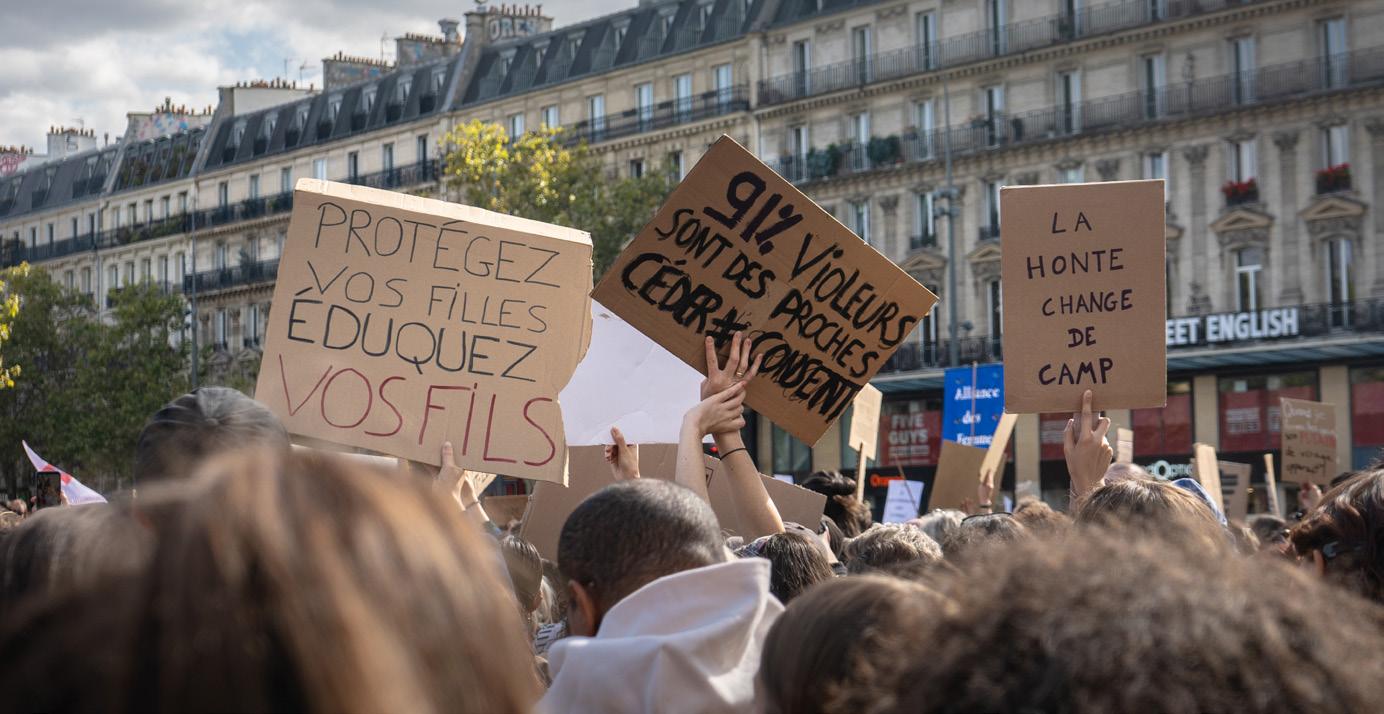
assault under the infuence but assault in general and male attitudes toward it. Women at the protest demanded, “Shame must change sides!”
On Sept. 14, I attended
a protest in Paris, one of many nationwide. Tese are some photos. By researching “Gisele Pelicot,” you can read more on this horrifying story.


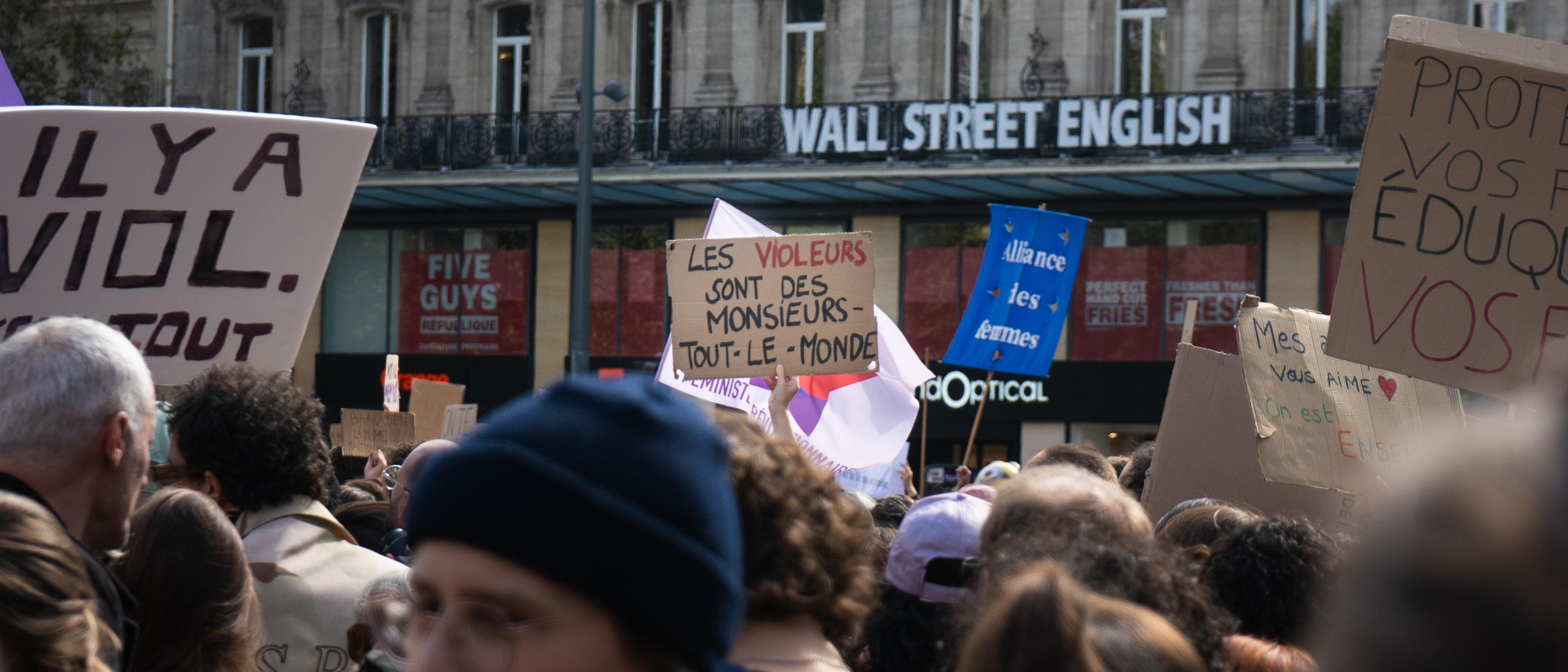
Enter digits from 1 to 9 into the blank spaces. Every row, column and 3x3 square must contain each digit. Each Sudoku has a unique solution that can be reached logically without guessing.
Answer to previous puzzle 09/26/24

“It is very difcult for children at the migrant center to participate in fun activities other than the activities provided by the childcare since the center is located a long distance from the city of Davis, and in most families, both parents work, so they cannot be taken to do activities outside the center,” Pena said. “Tis program brings the activities to the children.” Machado said the program gives children a unique opportunity to experience new activities.
District 2 Supervisor Lucas Frerichs also highlighted the mental health struggles community members continue to face in light of the pandemic.
“Mental health indicators were at epidemic levels prior to the pandemic,” Frerichs said. “Tey have only been exacerbated since that time, and it’s no wonder [...] why. Tere is so much work to do in reducing stigma and barriers to [begin] acceptance and healing.”
Some of the sponsors of the memorial included the Yolo County Board of Supervisors, the city of Davis and Davis Firefghters Local 3494. Davis Firefghters Local 3494 President Matt Fix said that, while frefghters are used to responding in moments of crisis, confronting the pandemic was diferent.
“During those long months, we found ourselves on the front lines in ways that we hadn’t before, knowing that each call we responded to carried new risks and who knows what else,” Fix said. “We weren’t looking for praise then, and I don’t think any of us are looking for praise now. We responded when the calls came in.”
Davis Mayor Josh Chapman also
While the Wall Street Journal’s ranking mainly focuses on postgraduate student fnancial success, other sources like U.S. News or Forbes rely more heavily on academics while in school.
“Being able to bring new experiences to youth who may not otherwise have the opportunity to experience them; demonstrating that public programs can and should be designed to meet the needs of the community; increasing trust and building relationships with underserved and vulnerable populations,” Machado said. “[All of these] increase resilience in the community.”
Te Davis Parks and Community Services Department works to improve access to recreational programming for underserved populations, including offering scholarship funds and enhancing enrollment processes. Te department plans to release a larger report on these eforts later this year.
spoke about eforts the city of Davis took to combat the pandemic. He said that the Healthy Davis Together program, a collaboration between several organizations aimed at preventing the spread of COVID-19, helped support struggling Davis businesses through the Business Partner Program. Te program supported businesses and local economy through a variety of resources and means, including free PPE [personal protective equipment], grant reimbursements of up to $5,000 for items that aided businesses in safely reopening, free COVID-19 testing for employees and their families [and] access to business ambassadors and public health specialists,” Chapman said. “During the program’s eightmonth run, a total of 424 Davis businesses participated, which is about 30% of the customer-facing businesses in the community.” Chapman said the pandemic emphasized how strong the Davis community can be in the face of adversity.
“When it comes to our families, our friends and our businesses, we are ready to step up every single time,” Chapman said. “Tat is what it means to live in Davis and to call this our home. Let’s hope that nothing like COVID-19 ever happens again, but if by chance it does, I know that we’re going to be okay.”
Despite the controversy associated with some modern college rankings, students at UC Davis confrm that they’re proud to go to a UC that is receiving more recognition than usual in recent years. Te Wall Street Journal ranking is one of many that has started to place some of the typically lowerranked UC schools such as Merced, Santa Cruz and Riverside as top public schools nationwide.

The disease is rapidly transmissible and can cause complications in vulnerable populations
BY ZAFREEN SHAIK science@theaggie.org
Last month, the World Health Organization (WHO) DirectorGeneral Dr. Tedros Adhanom Ghebreyesus declared the mpox outbreak, formerly known as monkeypox, a global public health emergency. Once limited to certain regions of Africa, the virus has now spread to over 122 countries, 115 of which had never seen a case before. With more than 100,000 confrmed infections globally, the resurgence — driven by the Clade IIb strain — intensifed concerns, prompting public health ofcials to mobilize eforts worldwide to contain the virus.
Dr. Dean Blumberg, the chief of pediatric infectious diseases at UC Davis Children’s Hospital, commented on the spread of mpox in an interview with UC Davis Health.
“Mpox clade 1 is what is circulating now in Africa — including African countries that haven’t reported cases of mpox in the past,” the article reads. “As of Sept. 3, 2024, cases have also
been reported in Sweden, Tailand and Pakistan after travel to Africa.”
Mpox is caused by the monkeypox virus, which is part of the Orthopoxvirus genus and closely related to the smallpox virus (Variola virus). While mpox generally results in milder symptoms compared to smallpox, its ability to spread rapidly and infect vulnerable populations underscores its signifcance as a public health threat. Transmission primarily occurs through direct contact with an infected person’s bodily fuids, respiratory droplets or contaminated materials such as bedding or clothing. Human-to-human transmission has been highlighted in recent outbreaks, particularly through close or intimate physical contact, making it a crucial component of the global spread in 2022 to 2023.
Clinically, mpox manifests with symptoms such as fever, swollen lymph nodes and a distinct rash that typically starts on the face or genital area. Te rash progresses through several stages, forming vesicles, pustules and eventually scabs. Infected individuals may also experience body aches and fatigue. Although
the disease is often self-limiting, complications can arise, particularly in vulnerable populations such as children, immunocompromised individuals and those in regions with limited healthcare access. Tis makes controlling the spread even more critical.
First identifed in monkeys in 1958, mpox was recognized as a zoonotic disease that could also infect humans. Its endemic presence in Central and West Africa is well documented; thousands of cases are reported each year in the Democratic Republic of the Congo (DRC). A notable event occurred in 2003 when an outbreak in the United States, linked to the importation of wild animals, highlighted mpox’s potential to spread beyond Africa. Tough this outbreak was quickly contained, it served as an early warning of the virus’ global reach.
Fast forward to 2024 and the ongoing global outbreak of Clade II mpox, particularly the IIb subclade, has led to widespread transmission. Although Clade I mpox has not been reported in the U.S., Clade II continues to circulate at low levels
in the country, raising concerns about sustained transmission. Global health eforts now focus on curbing the spread, especially in regions with fragile healthcare systems.
“Testing is key for people to get treatment and care as early as possible and prevent further spread,” WHO states. “Since 2022, WHO has delivered around 150,000 diagnostic tests for mpox globally, of which over a quarter have gone to countries in the African Region. In the coming weeks, WHO will deliver another 30,000 tests to African countries.”
At UC Davis and other healthcare institutions, telehealth appointments are available for individuals concerned about mpox exposure. UC Davis Health has also made mpox vaccinations available to high-risk groups, including patients, faculty and staf
Blumberg confrmed that JYNNEOS is approved for use in both adults and children, though it is not part of the routine vaccine schedule for children. In addition to vaccines, antiviral treatments and immunoglobulins are available, particularly for vulnerable groups like
infants under six months old. Te
JYNNEOS vaccine, administered in two doses, provides about 85% protection if given within four days of exposure and can lessen the severity of the disease if administered up to two weeks later.
As mpox continues to spread globally, UC Davis and other institutions across the US are responding by promoting vaccinations, increasing awareness and providing medical support to those at risk. While the overall risk remains low for the general population, vigilance, timely vaccination and adherence to public health guidelines are essential to keeping the campus and broader community safe from mpox.
“Expanding access to diagnostic services is urgently needed as tests are essential to critical measures such as strengthened laboratory capacity, improved case investigation, contact tracing, surveillance data collection, and timely reporting,” WHO states.
“As a package, these help countries identify chains of transmission, detect cases early, prevent further spread, and monitor the virus in real-time.”

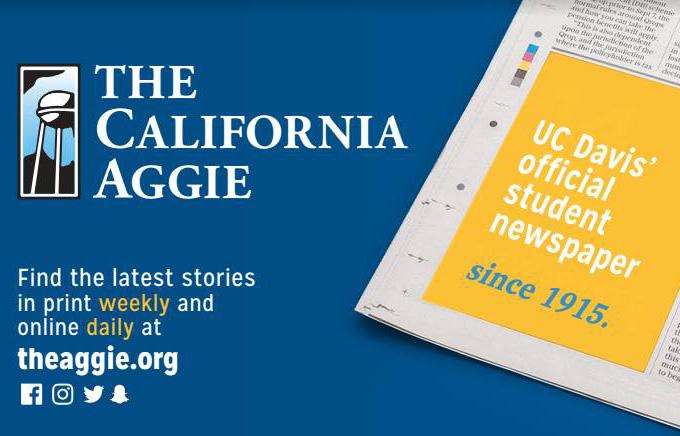
BY KRISTA HAJJAR sports@theaggie.org
As the basketball season is approaching, the UC Davis men’s basketball team has started solidifying their roster. One of the strongest players on the team in the 2024 season has decided to stay for another year, despite entering the transfer portal last spring. Te California Aggie recently had a chance to sit down with TY Johnson, a fourthyear communications major, to ask him about what he learned from his last season at UC Davis, what he’s looking forward to in the upcoming season and why he put his name in the transfer portal.
In the position of lead guard, Johnson believes he had to achieve a greater understanding of the game in order to advance his team.
“I learned a lot from being in that role, because I had to come in and produce more for our team,” Johnson said.
“I knew that I had to give in and to buy in more of the system for us to be where we want to be and to put us into the position where we were at last year.”
Johnson continued to note that it took a mixture of intense flm watching and consistently working with the men’s basketball coaches to make that huge stride between his frst and second year as an Aggie. Although he is reaching great heights now, Johnson said the journey to becoming a lead guard wasn’t easy with the new pressure that came along with it.
“In all honesty, I started the season of really rocky,” Johnson said. “I was putting too much pressure on myself.”
But, that rocky start didn’t deter Johnson from playing his best as he continues to stay true to himself on the court and break records. His goals for this season include winning Player of the Year, Defensive Player of the Year and securing frst place in the conference. His ambitions go past that of the Big West League as Johnson continues to note his bigger ambitions of being on the All-American stage.
“I know my expectations, and I know my coaches’ expectations and what it takes to get there,” Johnson said. After discussing the of-season and how the team has been using this past summer to strengthen their defense — what makes the team special and unique — Johnson also commented on the team as a whole.
“I feel like our team bonding, the things that we do of the court with
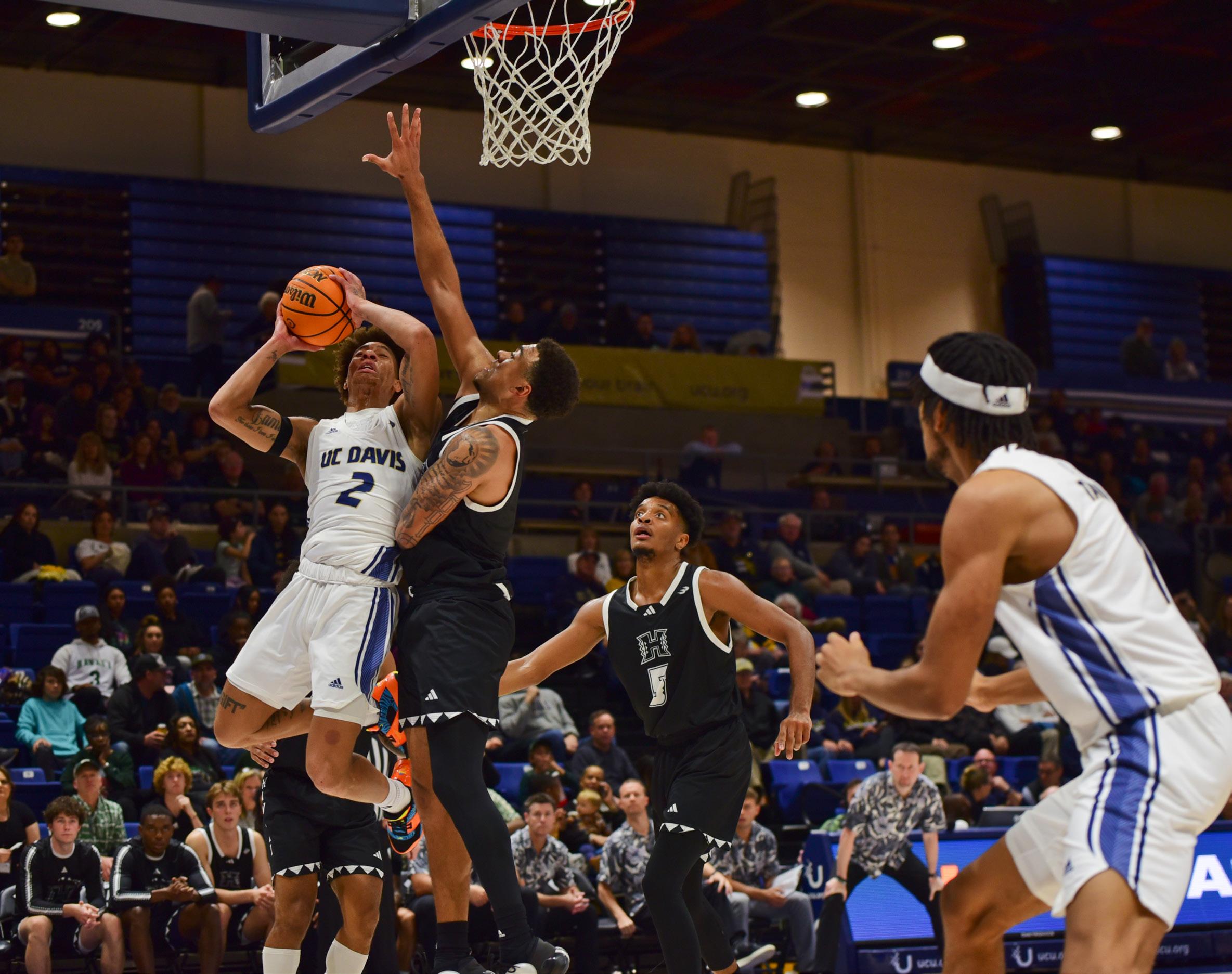
our coaches and how much time that we spend with each other makes us unique,” Johnson said. “Schools normally don’t do that, because I feel like a lot of college coaches are just happy to do their jobs. [...] Our coaches actually invest into us as humans before basketball players.
Tey really want to get that [...] brotherly connection within [the] whole team.” Johnson refected on a specifc moment in his career from his fourth year of high school that stays with him. Due to COVID-19, he had a shortened year and season — yet that was when he and his past team had their best season.
Even with less time competing on the feld, his team was able to take part in the Chipotle Clash of Champions
with the top eight schools in Illinois. Johnson and his team were frst up against the No. 1 team, with his team the underdogs at No. 7. Tey proved everyone wrong as they not only beat the No. 1 team but went on to win the entire tournament.
“[My team] played on ESPN, which was the frst time our high school was featured on there,” Johnson said. “I knew that was my [breakthrough] and I was going to take of.”
Te Chipotle Clash of Champions isn’t the only fond memory that Johnson keeps with him — a saying from his dad has also remained important in his life. Before every game, Johnson’s dad always tells him, “A lot of people will fall under pressure when the lights are bright.”
Johnson admitted that he didn’t really understand what his dad meant until recent years.
“People tend to fall under pressure in the biggest moments, but I’m never one to shy away from it,” Johnson said.
Earlier this year, Johnson placed a transfer portal request, informing his coaches of his willingness to transfer schools and play for another team.
“Tere was a lot that went into it,” Johnson said. “With me coming of a great year and season, I knew that I could play with anyone in this country [...] I love being tested and playing against the best.”
After speaking with Head Coach Jim Les, Johnson said that he wanted to explore his options and see where he stood. If Johnson were to leave UC Davis, he would need the school to
match what he was receiving: being lead guard, playing 30 minutes a night and having a similar team culture and coaching staf
Johnson ultimately made the decision in early summer to stay with the Aggies. After speaking to coaches at other schools, he failed to fnd a similar connection with the coaches, as well as other drawbacks, that ultimately led him to stay at UC Davis for his fourth year. “It was a tough decision, but it really wasn’t,” Johnson said. “After talking to these coaches and stating what I was looking for, I was able to make a pros and cons list which made it easy for me to come back and make my last year my best year at Davis.”
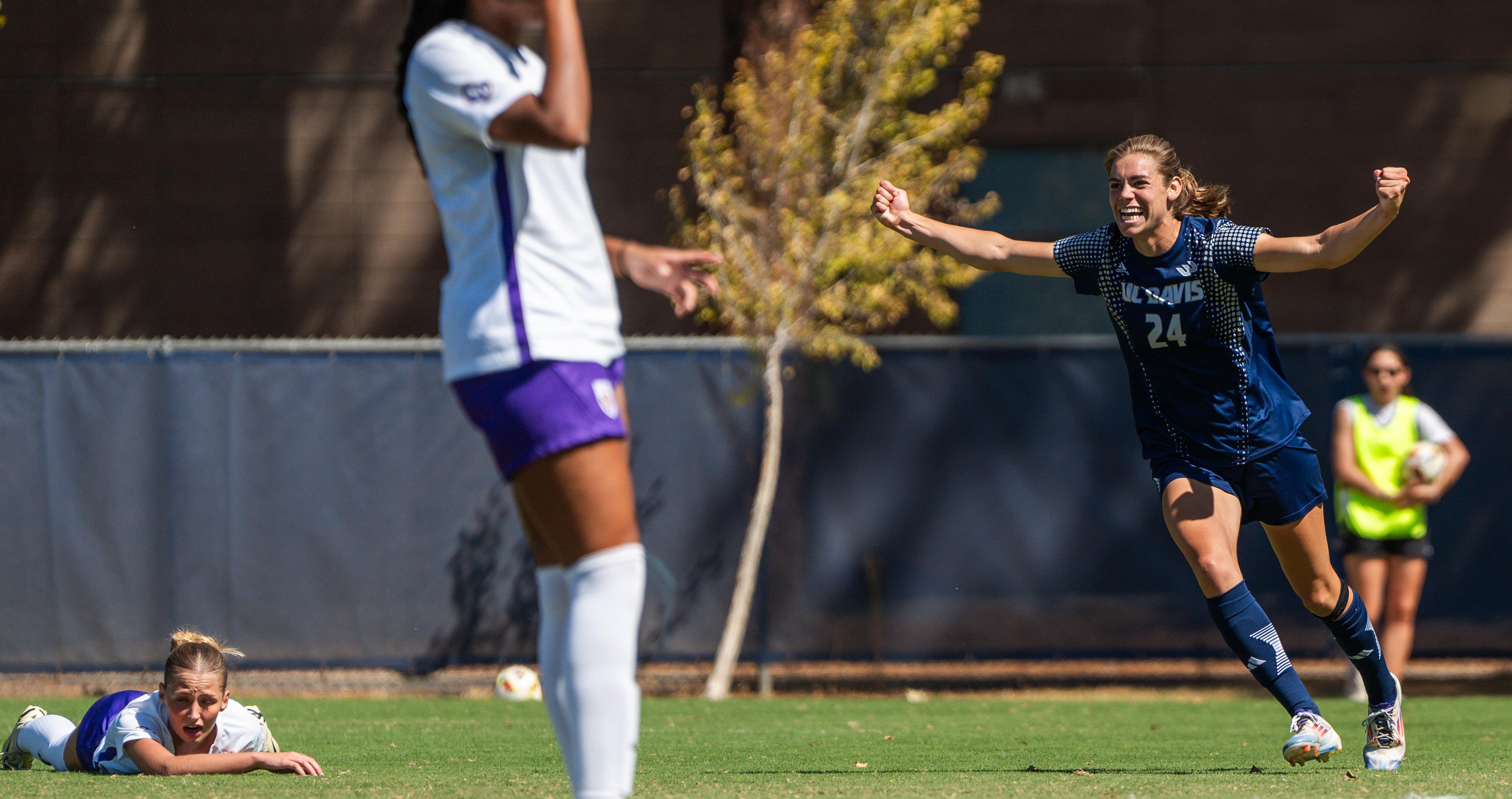
BY DIEGO CERNA sports@theaggie.org
accomplished this goal by pulling out a victory in the closely matched game, just beating out the LSU Tigers with a fnal score of 4-3.
Te Aggies started of strong, as Genavieve Fontes, a midfelder and third-year undeclared major, scored the frst goal of the game on a header from a cross-feld assist by Sammie Ruelas, a defender and fourth-year psychology major. Tis was one of the two goals Fontes scored in the game. Additionally, Fontes was named Player of the Week by UC Davis Athletics, the Big West Ofensive Player of the Week and the National Player of the Week by TopDrawerSoccer.com. In retaliation to Fontes’ score, the Tigers scored two goals from Mollie Baker, a forward and graduate student, and Andrea Iljikic, a forward and
second-year, gaining a 2-1 lead over the Aggies just before the 70-minute mark. Jayde Holley, a defender and third-year undeclared major, tied the game again at 2-2 on a free kick around a wall of Tiger defenders at the 77-minute mark. Just over a minute later, Sam Tristan, a forward/ midfelder and fourth-year, scored on an assist from Sydney Bushman, a frst-year midfelder, to give the lead back to the Aggies. Up 3-2, LSU responded by tying the game with a goal from Sage Glover, a third-year forward, in the 82nd minute. Fontes then delivered
the game-winning goal from an assist by Ashleigh Garcia, a midfelder and second-year neurobiology, physiology and behavior major, in the 83rd minute of the match. Tis win put the Aggies on top of the Big West Women’s Soccer Conference with an overall record of 7-3, as they remain the only team to have above a .500 win record so far this season. Tristan and Fontes remain tied for leading the Big West Conference in most goals this season with seven, the second closest player having four. Caeley Goldstein, a fourth-year goalkeeper, was also a signifcant factor
for this Aggie victory — making four crucial saves throughout the game. Tis was more than just another victory, as it marks history for the UC Davis women’s soccer program. With momentum swinging back and forth at the end of the game, the Aggies showed that they can keep up with anyone from any conference, no matter the competition level. Te Aggies now look into conference play for the remaining games of the regular season and hope to continue the winning streak.